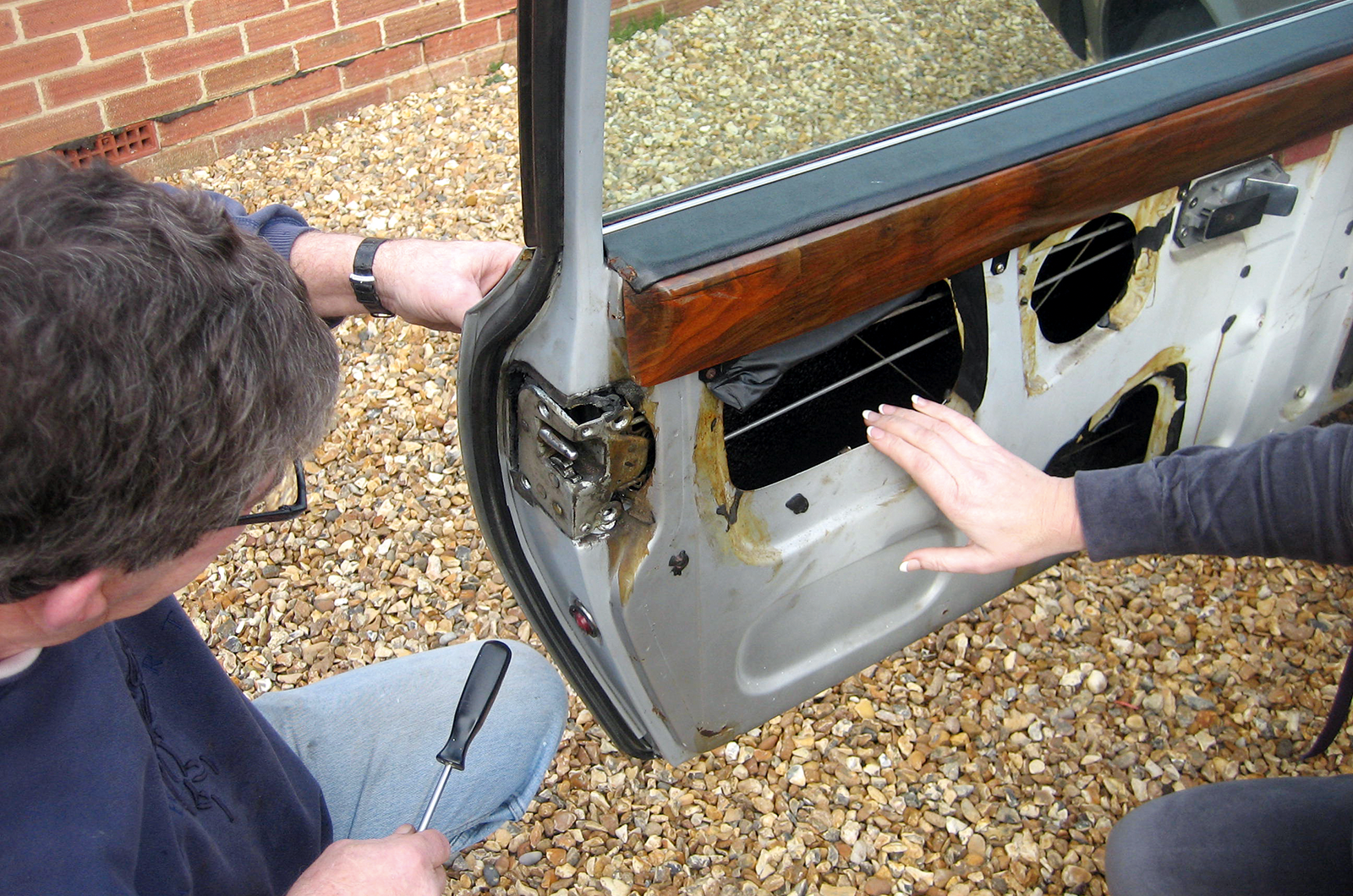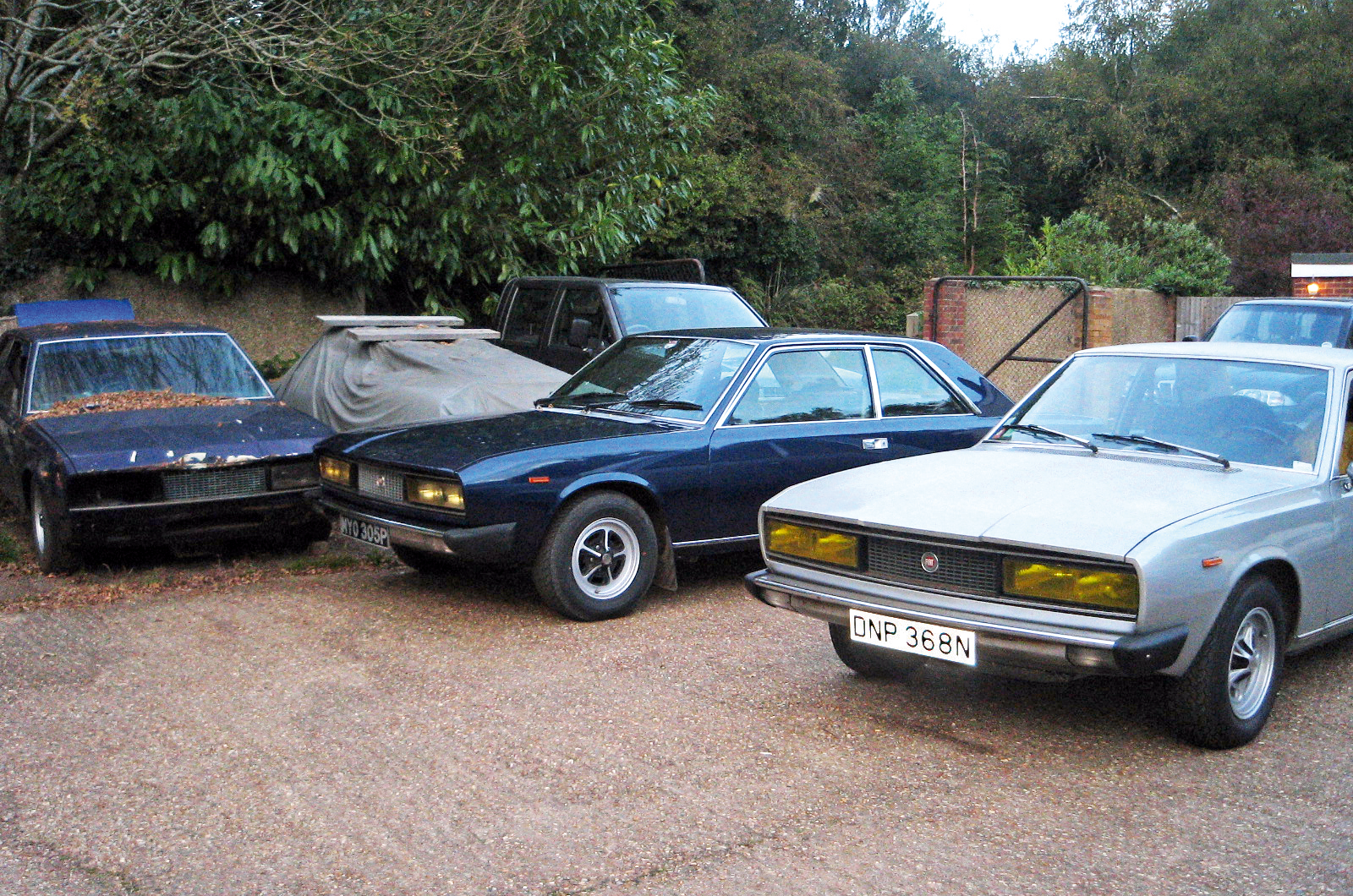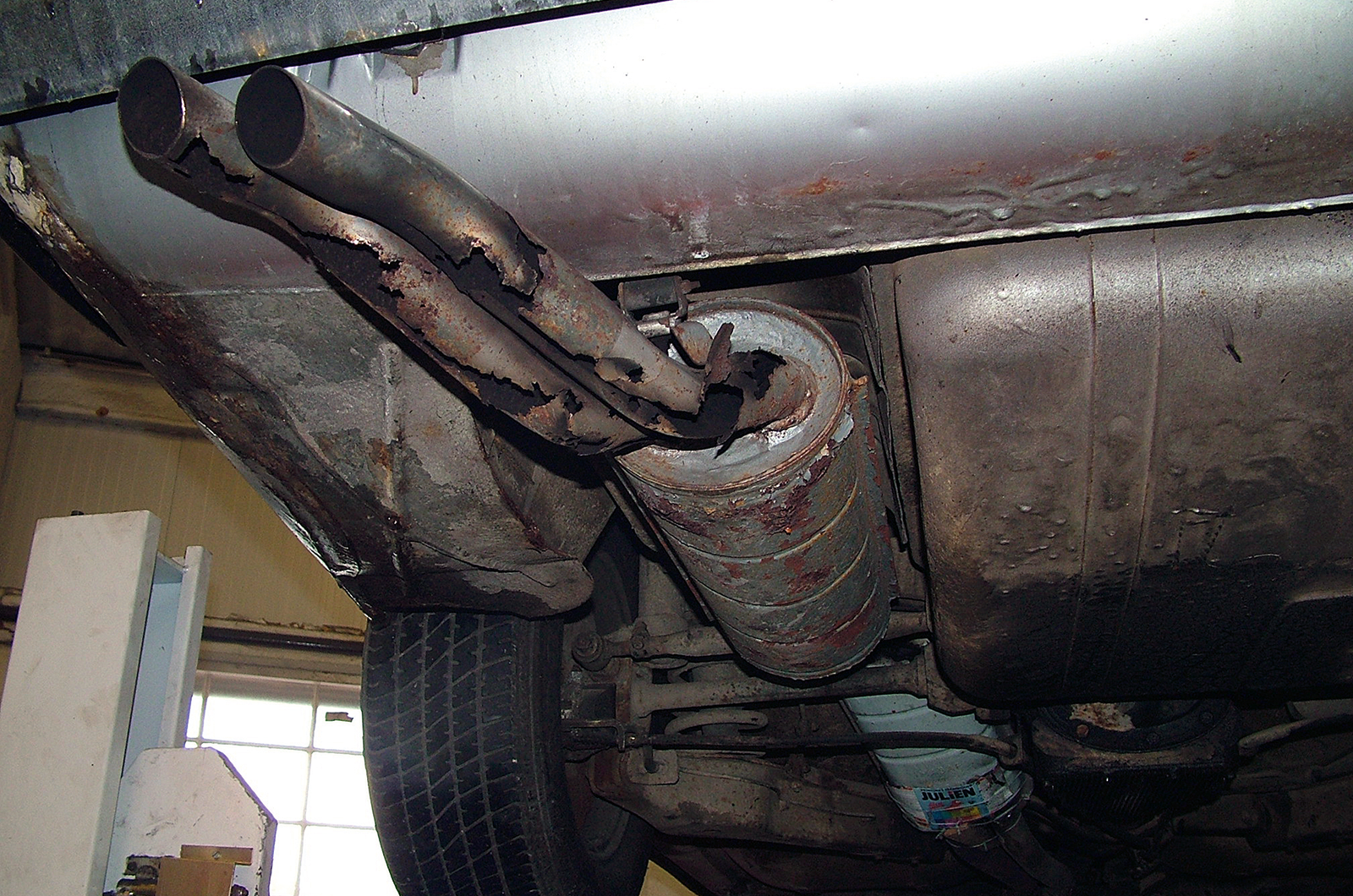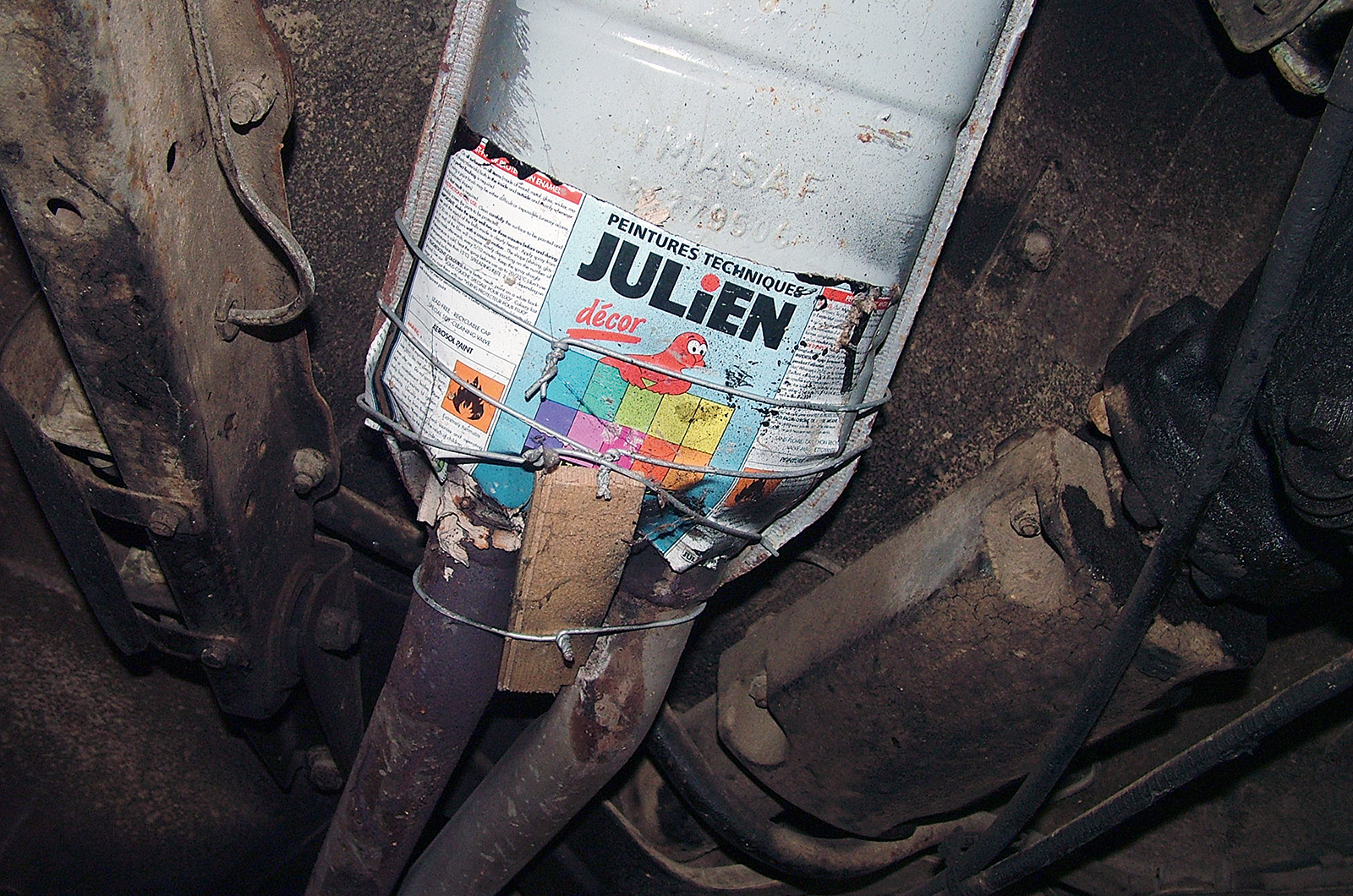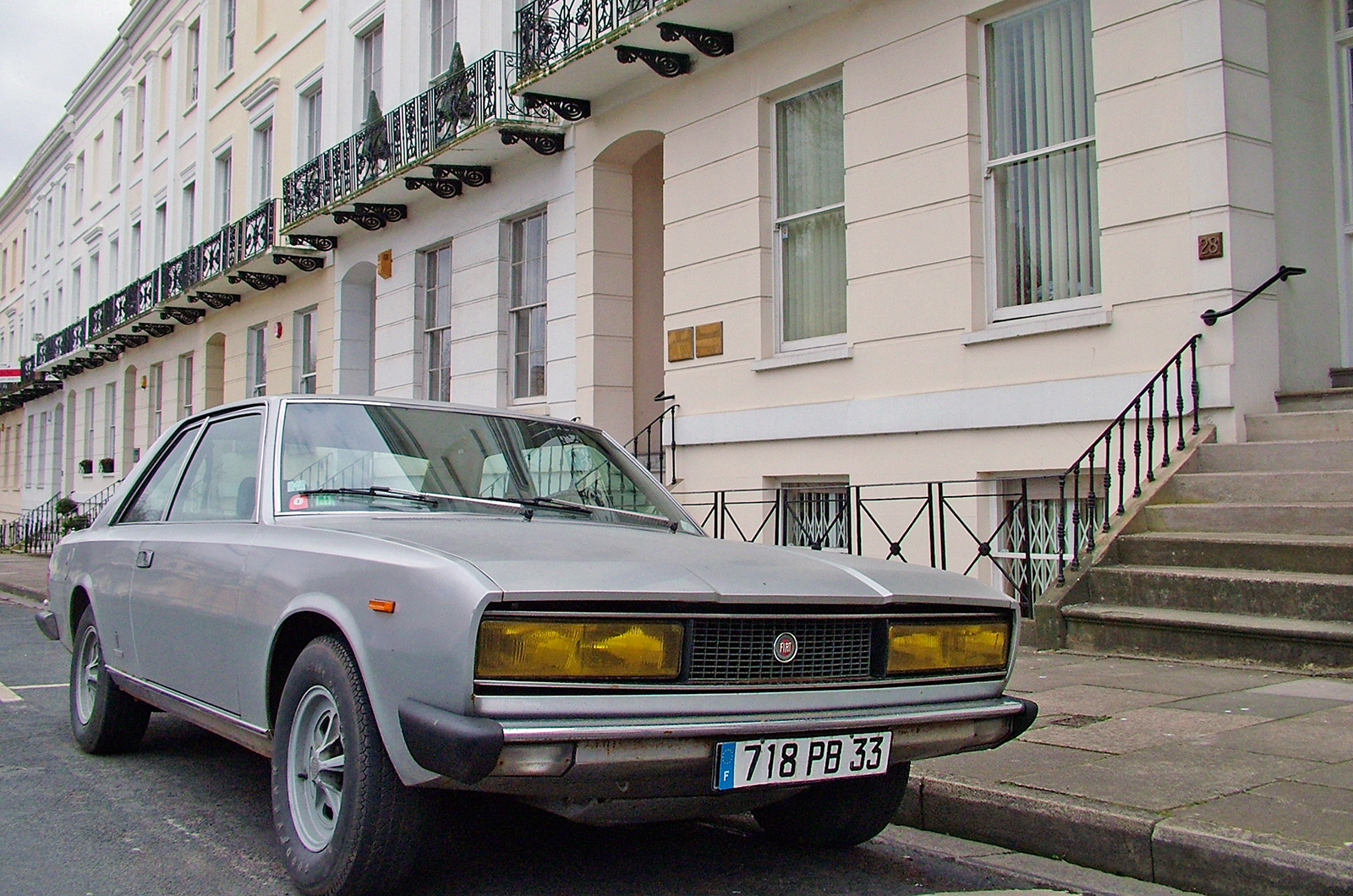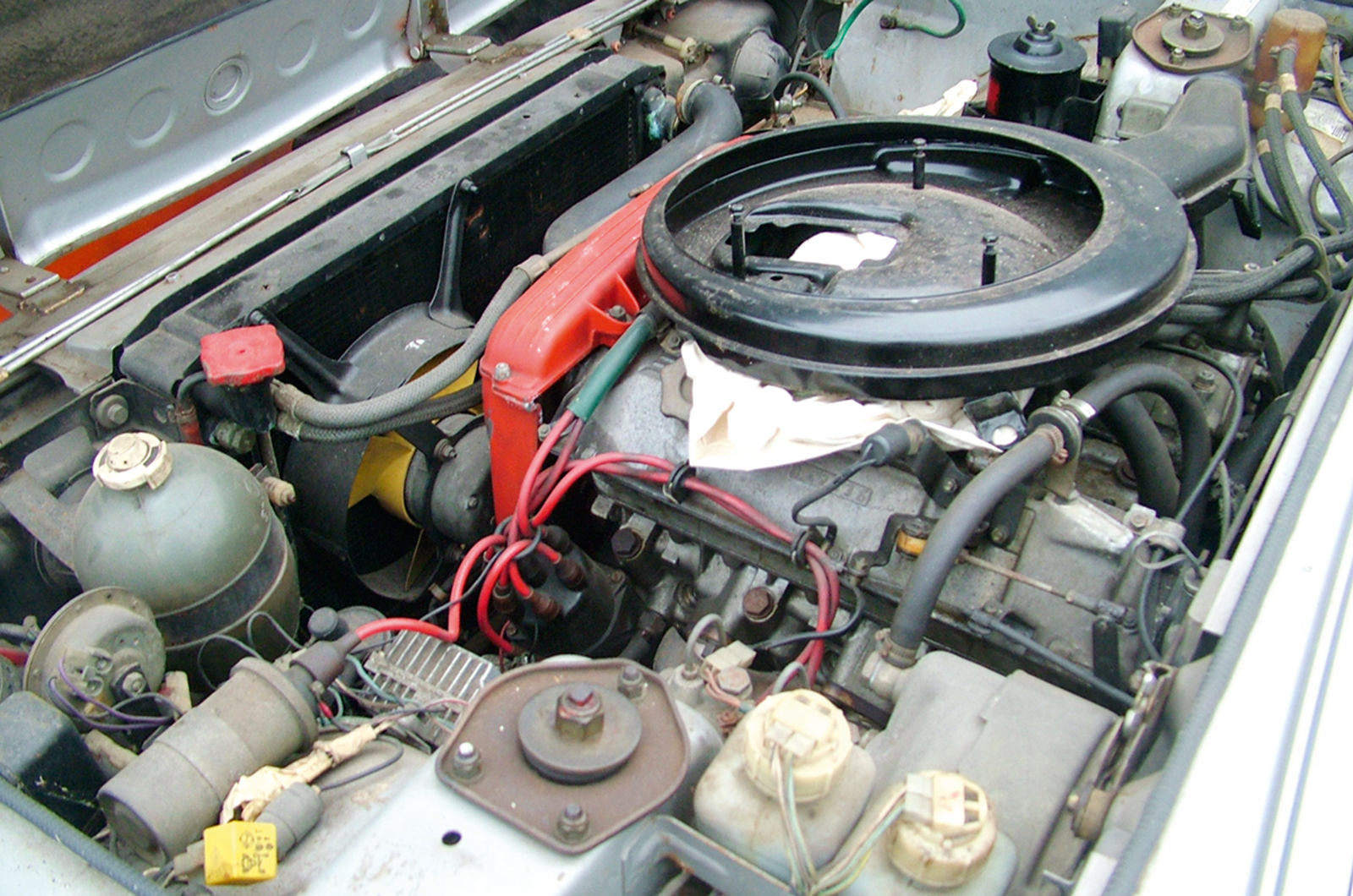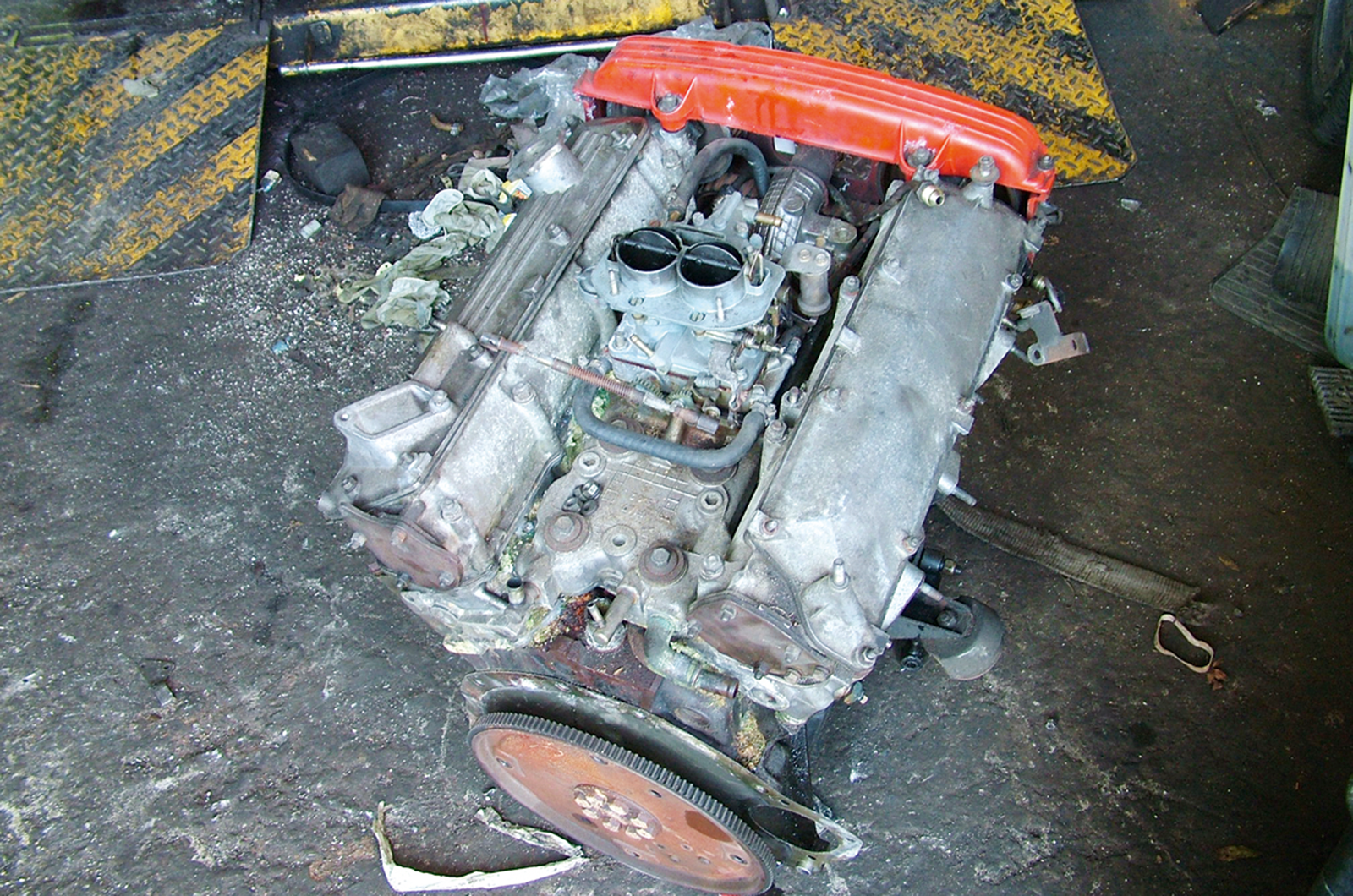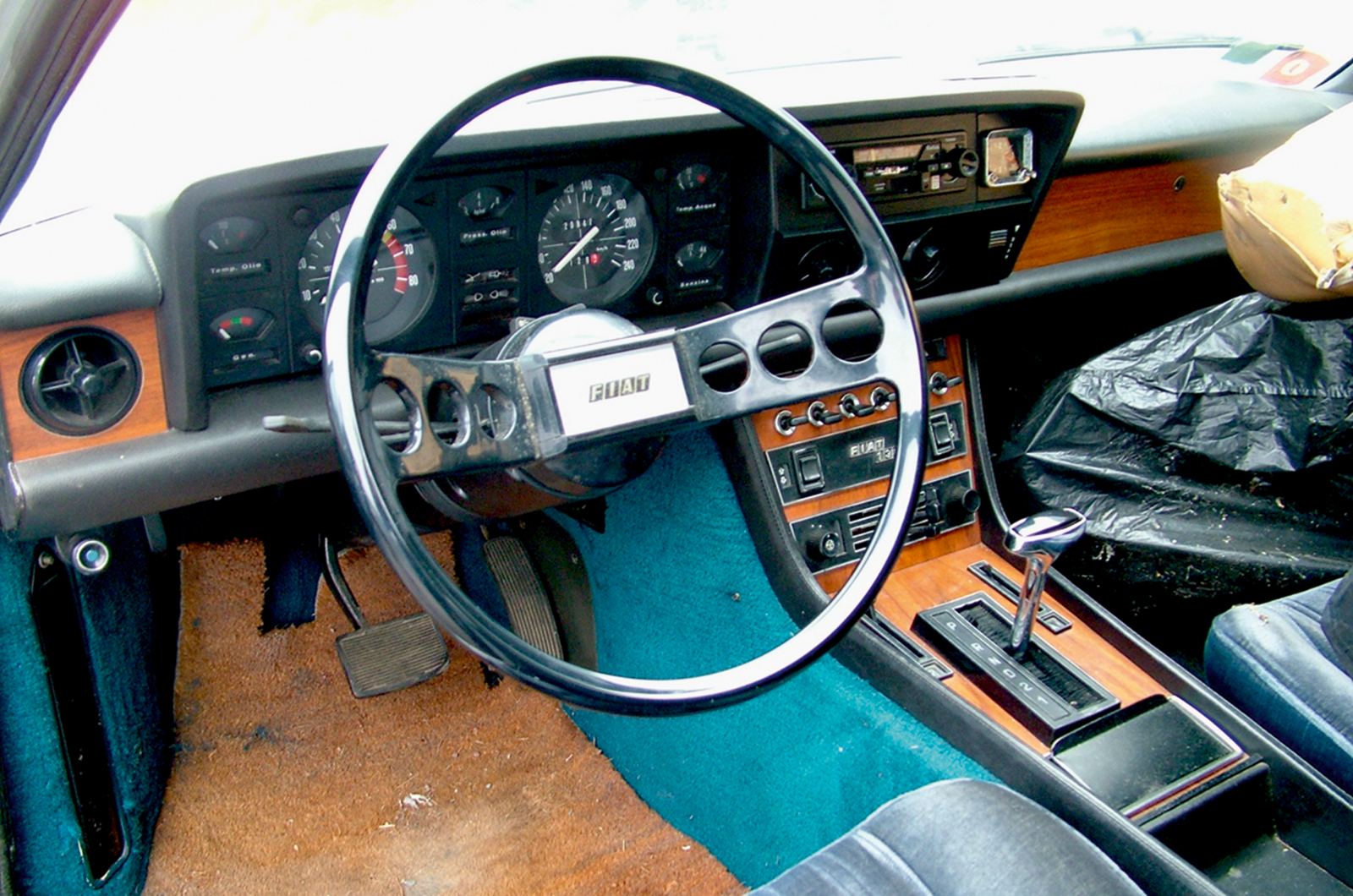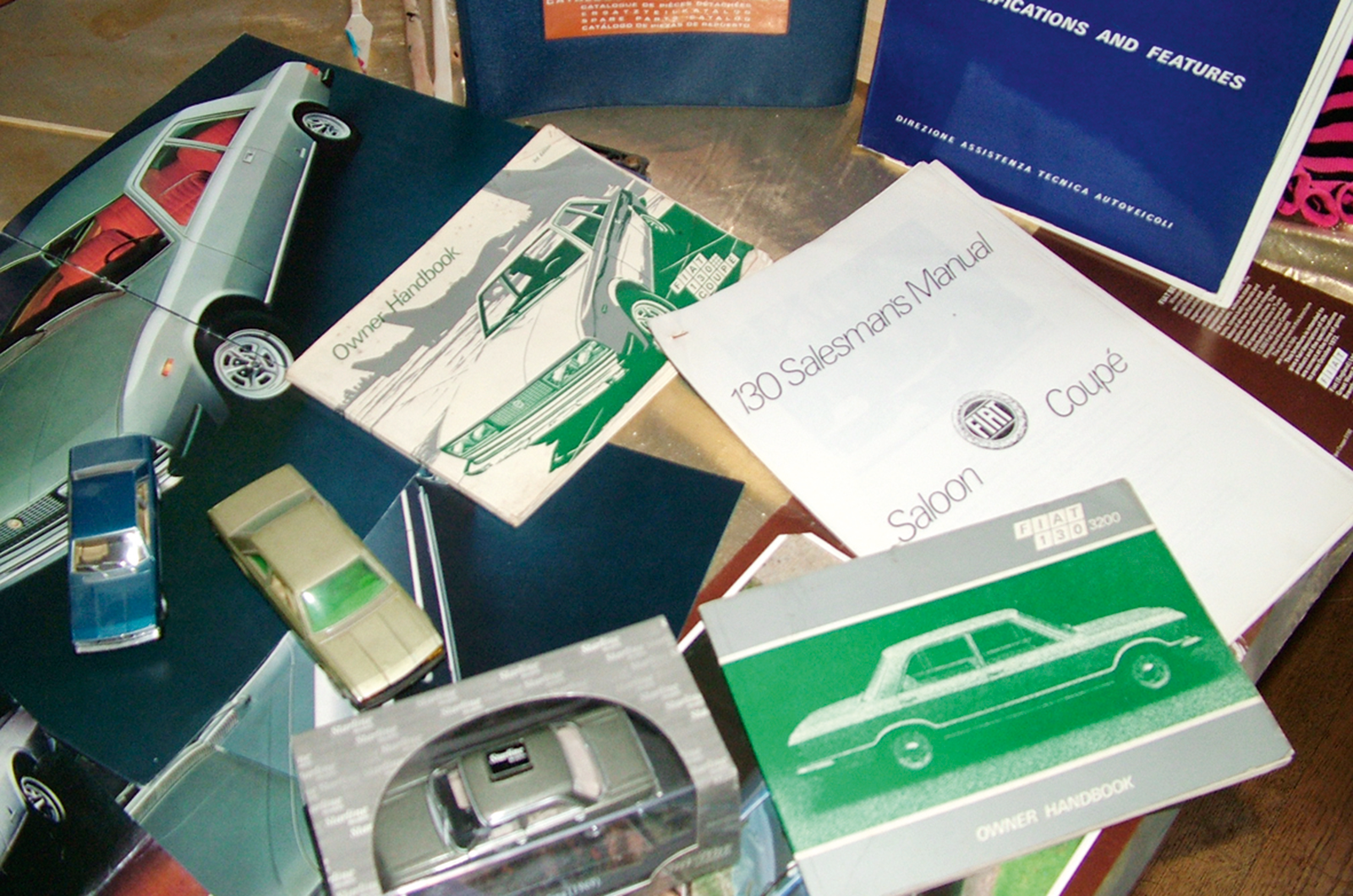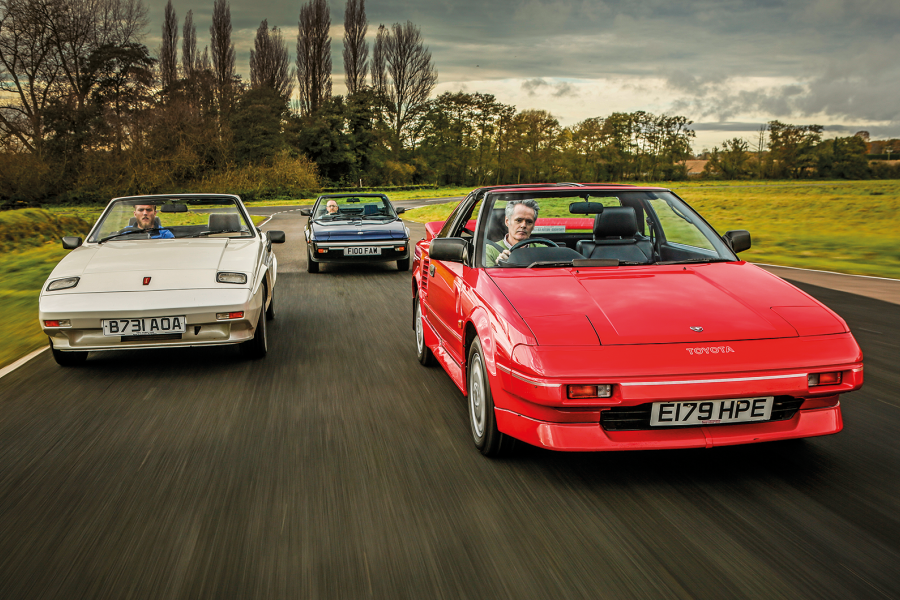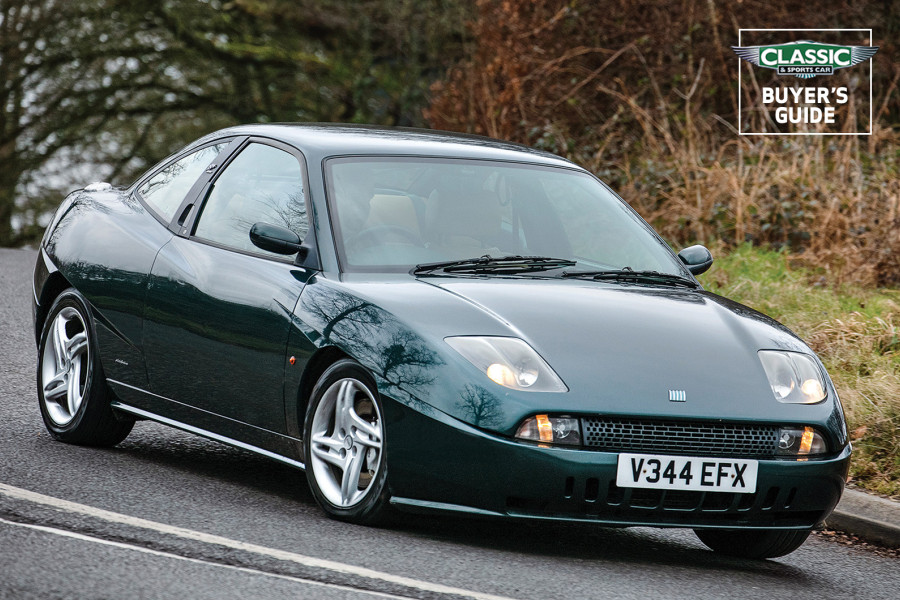To keep momentum behind the project, while John is away I asked Ian and Richard at UK Detailing just up the road in Ewen to spruce up the engine bay and recolour the seats. Everyone has commented on how good the Gamma looks inside now, so I felt that it would be rude not to give the Fiat the same treatment.
John had managed to fit the front seats the wrong way around in a ‘senior’ moment, which meant it was the ideal opportunity to have that rectified as well. Ian removed all the chairs and door cards, and even treated the black sections. The results are marvellous, and the engine bay looks great as well.
While they were at it, I asked them to fit the new Pininfarina badges on the quarter panels using a brochure for reference to make sure that they went in the right position.
The only problem was the alloys. Because they are actually magnesium, they don’t take kindly to being dipped in whatever acid the refurbisher uses. So, unless I wanted to pay £200 a wheel (I didn’t), we had to devise another plan for those. I even got hands-on and made the passenger-side powered window work while the door card was off.
Clockwise from top: On axle stands while rims are being done; V6 and bay have also had a good seeing-to: they are now unrecognisable from their grubby former state; brochure was used for badge reference
What remains are a lot of silly electrical issues; the fact that I still don’t have a functioning speedo is top of my list of irritations. So much time has elapsed since I was first given the kit for converting the unit to an electronic system – running off pulses from the propshaft – that I can’t recall if I ever had all the bits that I needed in the first place.
This was making my brain hurt, so I decided to get Gus Meyer (my Merc man from Swindon) involved because he relishes these kinds of jobs and doesn’t mind getting stuck into the internet to find whatever parts or information he needs.
I dropped the car off with him for an “initial consultation” for a list of faults that included slightly droopy suspension on the driver’s side (too many fat blokes driving it), the rattling exhaust and lack of charging.
I vaguely remember that the alternator is off a Peugeot 604 – and the wiring is all to cock – hence the under-bonnet red light rather than a proper indicator on the dash. Gus wants to tidy up all of this, reinstate the factory set-up and found me the correct alternator on good old eBay for £95. With that fitted, he can start tackling the rest in earnest and reckons that he will soon have a solution to the speedo problem.
The freshly painted 130 comes together – grille and Carello headlights were simple to fit
The Coupé has returned from the paint booth and the results are very pleasing. The time has now come to start refitting the jewellery, which, for those who know what they are doing (not me), is the nice bit.
My father in-law John Stewart has built up the rechromed bumpers with orange UK-spec indicator lenses (rather than white European ones). He’s also cleaned the rubber end caps, and the front bumper is ready to go back on.
Having been steeling himself to refit the notoriously fiddly doorhandles, getting them in was quite easy in the end. To make life simpler, I laid out the trim, lights and interior bits on a sheet next to the car and bought some free-standing lamps to illuminate the Fiat. It gets pretty dingy in my shed, even during the day.
We started at the front, where the headlamps and grille went back easily. Everything is being attached with new stainless clips and screws, while every orifice is getting a good dose of Waxoyl – especially the insides of the rear arches.
The nice chrome scuttle grilles that I’d been saving turned out to be no use, because they are the right-hand-drive type with the wiper arm holes in the wrong place. The originals are pretty good, though.
The only other car I know of that uses the same front-wing indicator repeaters is the Ferrari 308GTB at £70 a set, so John decided to repair the ones we had. The results have apparently been successful, although I have not yet seen them.
(l-r) New carpets replace the original blue ones; refurbished indicators are fixed in place
I was unhappy with the combination of blue carpets and cream seats, and realised that the only answer was new carpets. David Barker in Faringdon picked a shade that would complement the leather and echoes the colour Fiat would have used in 130s with Champagne velour, on the assumption that it would use the same with cream leather.
Factory carpets were moulded in one piece, but the new ones are in several different parts with the joins strategically hidden. I think the tilting mechanism on one of the front seats is going to need attention, but I saved one of the blue velour seats and should have all the bits we need to repair it.
At some point the windscreen developed a crack, but this was a blessing in disguise. Pulling it out revealed a couple of holes in the aperture that we were able to get repaired, and the ’screen itself was misted in the corners anyway. The new one should be ready any day.
 The 130 Coupé has made its way to Cotswold Classic Car Restorations’ bodyshop, and any day now will have a new topcoat on it – I’m just awaiting the colour code from Italy.
The 130 Coupé has made its way to Cotswold Classic Car Restorations’ bodyshop, and any day now will have a new topcoat on it – I’m just awaiting the colour code from Italy.
The Fiat had to be buzzed down to bare metal in places, the paint having become pickled after its years in the south of France, but the epoxy primer that Jonathan Wills has used is less likely to be affected by moisture.
For those using this two-pack system at home, he tells me that you can roller it on rather than spray if you don’t have a ventilation system. What then follows is a laborious process of ‘keying up’, applying filler to get flat panels – of which there are a lot on the 130 – and making sure that the various feature lines are correct.
There is a slight debate about whether to use resurfacing spray filler, which saves a lot of donkey work but can absorb moisture and lead to problems later. The alternative is a high-build primer, then a rub down with 180-grit to get rid of the coarser scratches that can re-emerge when the topcoat sinks. John’s preference is wet flatting with 800 wet-and-dry, priming and then blocking back with a ‘stain’ to highlight any pinholes or high points.
Another important thing at this stage is to do a ‘dry fit’ of the various fixtures and fittings before the topcoat goes on. You don’t want to find, once the car has been painted, that mouldings, doorhandles or anything else won’t go back into place properly because a shape has subtly changed in the refinishing process. Once that’s done, there will be three or four coats of base coat plus the same of lacquer.
Having sat idle for many months now (its last MoT was in 2013, I think), the engine doesn’t want to start, so it’s been a case of pushing the Fiat everywhere. I have reconciled myself to the biscuit-coloured leather interior, which goes well with the blue carpets and the silver body, and for now I have given up on getting someone to tackle the instruments. You might recall that the car is fitted with a four-speed ZF ’box from a Jaguar XJ40; it works beautifully but has an electronic speedometer drive, which will necessitate a conversion kit if the speedo is ever going to function.
The 130 Coupé is now in primer, just to preserve it until it is resprayed. John Stewart has removed all the chrome and the doorhandles, and has taken a set of headlamps away to refinish the shells in black. I shall have to give some further thought to what else under the bonnet needs tidying up: there is nothing worse than looking at a messy/grubby engine bay on an otherwise smart, freshly repainted car.
Stewart has spent a certain amount of time with the DA machine getting back to bare metal where the original paint had pickled in the South of France sun, generally cleaning up surfaces on the bonnet, bootlid and roof. But the majority of the prep will be done by Jonathan Wills of Cotswold Classic Car Restorations.
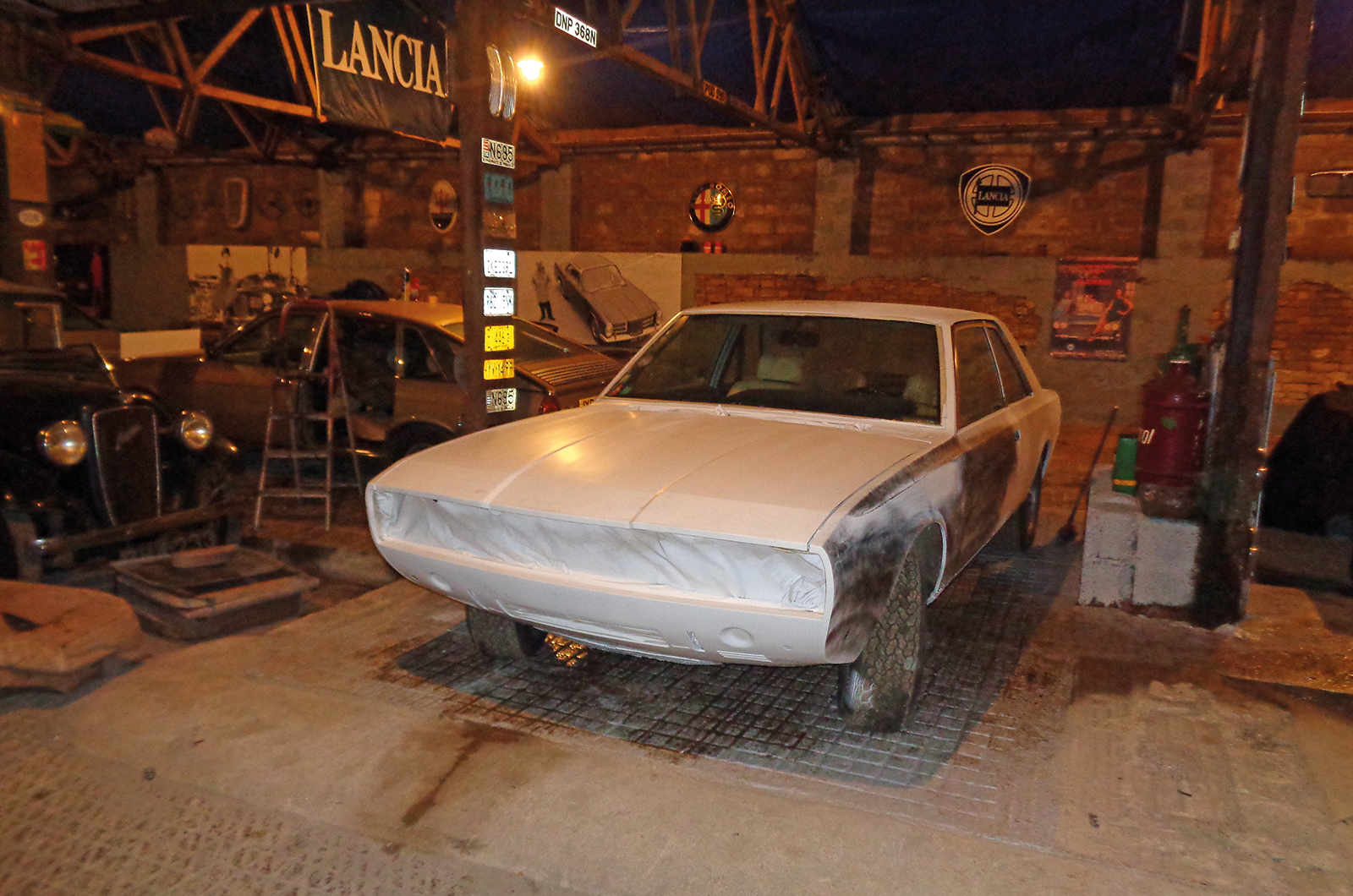 Jonathan sat me down and gave me a little talk about spraying cars. “The original paint on your Fiat is bleached/oxidised so we will have to go back to bright metal,” he said. “The trouble is, it is now unstable so you don’t want to be covering that surface with modern solvents and thinners because it reactivates the original coating. Modern car paint is better: it uses a system whereby two chemicals react with each other and set them off hard rather than relying on the old in-air drying process so they are more durable and not as susceptible to acids in bird poo and so on.
Jonathan sat me down and gave me a little talk about spraying cars. “The original paint on your Fiat is bleached/oxidised so we will have to go back to bright metal,” he said. “The trouble is, it is now unstable so you don’t want to be covering that surface with modern solvents and thinners because it reactivates the original coating. Modern car paint is better: it uses a system whereby two chemicals react with each other and set them off hard rather than relying on the old in-air drying process so they are more durable and not as susceptible to acids in bird poo and so on.
“On your Fiat we need to make sure the bodywork is refinished to ensure it is straight. You get build-ups of paint with multiple resprays and repairs, which means the paint has to be stripped back if you don’t want a wobbly surface, but your car looks like mostly the original finish.
“Typically, we would use a body-etching epoxy primer that eats into the metal to protect it and provides a key for the other coats of paint. Bare metalling all over is the best way to do it, but takes many man hours, so, to keep costs down, it has been decided that the paint on the flanks of the vehicle has suffered little UV damage and retains many good properties of adherence.
“In the way that modern paints are superior, the old lead-loading technique of panel refinishing was a lovely way of doing things, but it can result in problems if the tallow that you use to spread the lead (an animal fat) gets trapped under the lead. That causes blistering. Modern body refinishing products are more stable and easier to use for the unskilled, but lead can hold a panel together when all the metal behind has rusted away. Front wings beneath the headlamp of the XJ-S are famous for this.”
Jonathan will use a high-quality polyester-based filler to smooth the body of any hammer marks and deviations on the Fiat. “There are spray-on fillers, but I am not a fan. They absorb moisture; it’s a cheap, quick way of getting the body shape right. We will refinish the body by hand to a smooth surface.
“The high-build filler primer takes out any minor fine scratches before the top coat application. It’s a real skill to get the final finish, taking years to learn. Those with the craftsmanship are scarce.
“We will test-fit bumpers, badges and so on after it’s primed so we don’t have problems fitting up when it’s painted. What can happen is that holes fill up with paint – and you don’t want to be drilling them out after it’s sprayed. Your car is all flat panels, which brings its own problems, but silver is relatively forgiving compared to, say, black.”
I bought some leather balm from The Furniture Clinic to freshen up the hide upholstery, but I probably won’t be getting round to that until Stewart wakes up from hibernation to refit the painted car with its bumpers, lights, handles and window trim.
The body restoration of my Fiat 130 Coupé is now under way. Dave Wills, all-rounder at Cotswold Classic Car Restorations (01793 752195), removed the bumpers, lights and badges for me, which got some momentum into the project. I then dug out my best two bumpers – acquired from various parts cars over the years – and sent them off to S&T Plating, just down the A46 in Yate, having accepted its quote for £700 and a six-to-eight week wait for the work to be finished.
Since then, my father-in-law John Stewart has removed the seats, let in a new rear wheelarch on the driver’s side and has made a start on the bottom of the front wing. He will pretty much repeat the process on the passenger side, cut the (faded) paint back all over, then send it in for priming and painting. All of that sounds okay if you say it quickly enough, but it involves a lot of graft plus several difficult decisions being made that wouldn’t have mattered much if the car had been left as it was.
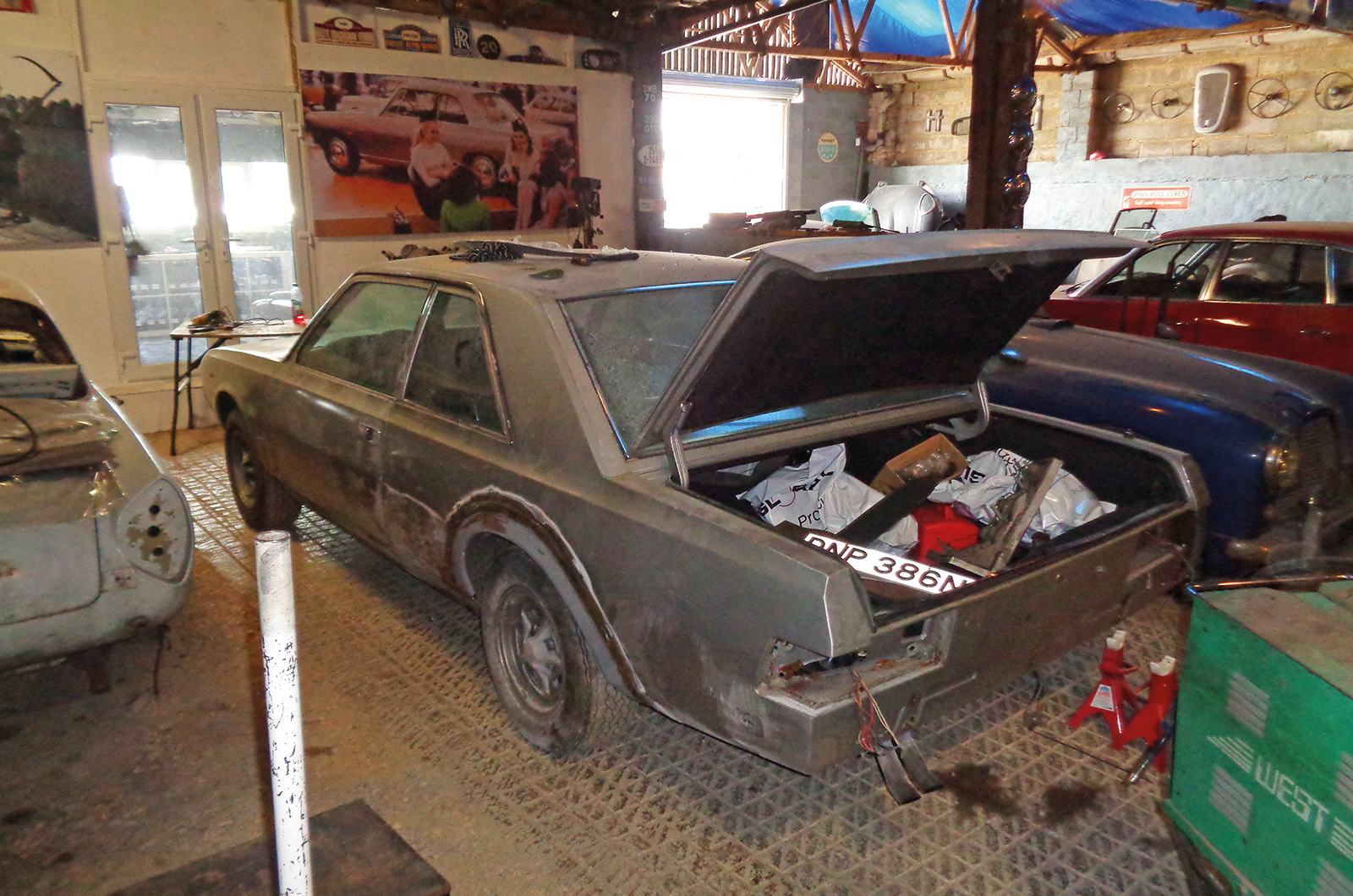 The biggest question was what to do with the faded and scruffy blue velour/velvet interior. In many ways this has always been a big part of the model’s appeal, both when it was new and now. The problem is that the stuff doesn’t last and no trimmer will accept the challenge of letting good pieces of spare velvet into what is already in the car. The stuff is just too fragile, particularly when the sun has got to it and left it brittle and prone to splitting. From what I can gather, everybody is having this problem with Fiat 130 Coupés that have had any kind of serious use.
The biggest question was what to do with the faded and scruffy blue velour/velvet interior. In many ways this has always been a big part of the model’s appeal, both when it was new and now. The problem is that the stuff doesn’t last and no trimmer will accept the challenge of letting good pieces of spare velvet into what is already in the car. The stuff is just too fragile, particularly when the sun has got to it and left it brittle and prone to splitting. From what I can gather, everybody is having this problem with Fiat 130 Coupés that have had any kind of serious use.
There were multiple avenues of enquiry open to me. The first was to try to find somewhere that sells the material, or something as close to it as possible in colour and texture. Lancia friend Rijk Heuff suggested that I speak to his wife Liz, who knows about these things having once run a curtain business. I had high hopes when she gave me the details of a company called British Velvet, but sadly it returned my samples within a week saying sorry, it had nothing like it.
Andrea Brunattzi – who has links to all things 130 in Italy – said he could probably help with an orange/ginger interior. That was worth thinking about, but would obviously have required changing the door cards and carpets. I even contacted Paolo Martin, the designer of the Coupé who specified the interior, but, 45 years on, he couldn’t remember where the material had come from. He kindly said that he would ask around to see if he could find out, though.
Then, when I was at the Beaulieu Autojumble someone gave me the number of a man in Cornwall called Andrew Morris, saying that he was ‘obsessed’ with Fiat 130 Coupés and would probably be able to help. I rang him and it turned out that we had done business before. No, he didn’t have an interior, but he suggested that I join his Facebook group Fiat 130 Cars of the World and put out a request there.
At first there was silence, but after a day or two a member called Steve Bolton said that he had a leather interior from a scrap car, and would I be interested in that?
Normally one jumps at the chance of getting hold of hide seats for anything that generally came with cloth, but in the case of the Coupé the original material is so lovely that I’ve always been rather disparaging of those who have gone down the leather retrim route.
But these seats were in cream – which goes with the silver body and the blue carpets – and were factory originals. This was one of the few options – along with electronic ignition, air-conditioning and the almost-mythical five-speed manual gearbox – that you could get on the otherwise very fully specified super-Fiat.
Despairing of ever tracking down a really good set of blue velvet chairs – and being wary of getting involved in an expensive retrim in something ‘nearly’ right and then being eternally dissatisfied with it – hide seemed the only way to go.
So I’ve decided to opt for those, and will be sending them to trimmer Dave Barker in Faringdon, Oxfordshire, for repairs and a clean. Meanwhile, though, Paolo Martin has come back to me with the name of a company that supposedly supplies the correct velvet…
Before I embark on getting the body and paint sorted on the Fiat 130 Coupé, my first priority is to get it driving properly and make sure that everything is working as it should. That way, once the car is finally looking smart and shiny, I hopefully shouldn’t find myself having to pull it apart again.
A real cause of frustration has been the lack of a functioning speedometer since the car received its new four-speed ZF gearbox. I understood that some kind of electronic alternative would have to be devised (probably taking its readings from the propshaft) but what I didn’t want was an ugly digital readout in place of the original analogue Veglia unit.
Black magic: Cable X should sort speedo
On hearing of my dilemma, Borgward enthusiast John Wallis kindly donated a box of tricks called Cable X, sold by a company called Abbott Enterprises in Arizona. It’s basically an electronic ‘dip switch’ that you can configure to the particular tyre size and final-drive ratio of your car, and takes its readings from a magnetic sensor that runs off impulses from the propshaft. Perfect! The only trouble was, I needed the $250 magnetic sensor for the thing to work.
I ordered one online from Abbotts and then forgot all about it until just before Christmas, at which point I realised it had been a long time coming. It turned out that it was in the country, but nobody could tell me where. Despite my short temper, Abbotts was very helpful and sent me another by FedEx rather than US Postal Service, the unit arriving just a few days later. Sorry if I was a bit rude guys. Jon Wills of Cotswold Classic Car Restorations has promised me that he will fit the new set-up any day now.
It’s always a worry when a spares car turns out to have more going for it than the one that you are running or restoring. It is a cold feeling that has struck me several times over the years and it happened again when
I laid eyes on the silver 130 Coupé that my friend Richard Close passed to me a couple of weeks ago.
Apart from the lack of an interior (which I grabbed a few years ago), it seemed better than I remembered. That was only a superficial impression and, anyway, what with its seized engine and a hole where its transmission used to be (Richard bought it because of its rare manual ’box), it would involve a shedload of work to get it back on the road.
Spares car, right – sorry, left! – was much better than Buckley recalled, with smart paint
There are plenty of lovely bits on it for my left-hooker, however – including clear-glass UK headlights – and I reckon that the bodyshell is good enough to put to one side as the basis for another car some day. It’s certainly too good to scrap.
I have known this particular 130 Coupé for decades. I first saw it in the early 1990s at Richard Thorne’s Lancia Emporium when the then-owner was having the manual ’box fitted and the interior retrimmed with red hide; that’s long gone, but the refurbished wood and leather headlining are still in place.
The bloke funding this work was one of the guys behind the Forbidden Planet bookshop, who I recall as having a black 130 auto as a runaround. I had several conversations with him at the time, but about 10 years ago I found myself inspecting the Fiat in a yard at a Cotswold garage, when it looked rather sorry for itself thanks to a wiring fire.
Stuart Ager, who runs Andrew Brodie Engineering, subsequently acquired it – he had the seats for his own car – and he sold it to Richard, who has now forsaken 130s for a Lamborghini Urraco.
The two jobs I would like to get under way on my car are finding a trimmer to do something permanent with the seats because the original upholstery seems to be getting more fragile, plus a proper sort-out of the exhaust: it still rattles, which I think is due to the fact that it just doesn’t fit. Luckily, there’s a nice-looking stainless-steel system in the boot of the spares car!
With the Fiat back on the road – I used it for the run to Goodwood for last month’s Alfa Spider cover story [C&SC May 2014] – and sporting its new gearbox, I resolved to get some of the niggles sorted. Brian Ingham of CBD Service Centre, just across the road from my Cirencester home, was happy to take a look at my list.
In his early days, Brian spent many happy hours servicing and rebuilding decaying Lancia Betas and Ford RS2000s, having served his apprenticeship at Sam’s Speed Tuning in Collyhurst. The boss was an Iranian who had worked in the Shah’s garage and came to the UK in ’79 after he was deposed, when having that job on your CV can’t have been healthy.
Ingham remembers Merc 600s turning up for service “full of sand” and has vivid recollections of one of the seven right-hand-drive Ferrari Daytona Spiders arriving one day, dismantled to its main components. He was tasked with machining a new part for the clutch mechanism and recalls a wild ride down Ashton Old Road: “I had to hold the door shut because the locks weren’t fitted and I didn’t have a seat; I remember getting fired almost into the boot when the boss put his foot down.”
The exhaust has always rattled against the body on the Fiat and, with the new gearbox mountings, this noise has assumed unbearable proportions. Brian re-drilled and moved the gearbox mounting plate, which has hopefully done the trick. I was conscious that the rear pads sounded as if they were metal-to-metal on the run to Goodwood, so I found some new ones on eBay. This turned into a right palaver: they were wrong, as was the next set I ordered, and in the end Brian had my originals re-shod. Can anyone throw light on what other car they fit, for future reference?
He also freed off the front brakes and popped on the set of pads I already had in the boot and hadn’t got around to fitting; freed off the handbrake; and changed the dark brown and ancient brake fluid. I’m now looking forward to some improved stopping power.
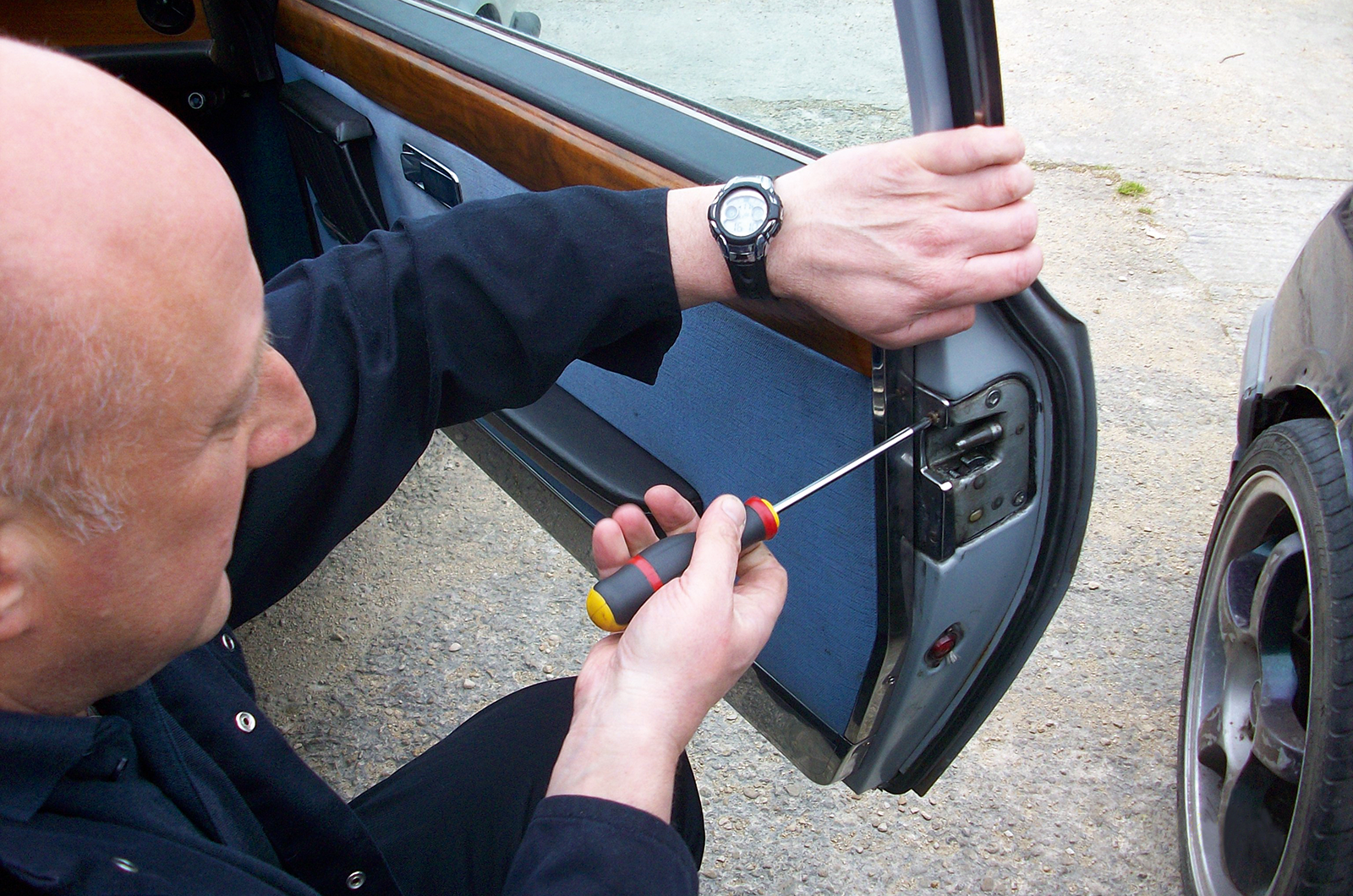 The interior doorhandles are notoriously fragile on 130 Coupés, so I found enough remnants of part-dismantled items for Brian
The interior doorhandles are notoriously fragile on 130 Coupés, so I found enough remnants of part-dismantled items for Brian
to make up a complete good one and fit it on the passenger side. The door lock/catch itself was worn, too – and there is no adjustment on it, really – so I found a better one in my cache of 130 parts, which Brian is fitting as I write.
He has also replaced various bulbs and rebuilt the innards of the nearside-front wing repeater. The final job on the list is the electric aerial, so that I can listen to Radio 4 again, rather than Tom Jones’ Greatest Hits on an 8-Track loop.
I finally collected the Fiat from Mark Devaney at 24 Hundred in early February, keen to find out how the new four-speed ZF automatic gearbox (which had replaced the original Borg-Warner three-speed) had influenced the car’s performance and overall character.
To recap, I bought a conversion kit from New Zealand probably 18 months ago and ended up with two scrap Jaguar XJ40s after they had donated various gearbox and propshaft bits – although I actually had a bespoke prop made up. In hindsight, I should have bought a BMW 5 Series donor because the Jaguar’s electronics don’t work with the Fiat’s speedo. I need one that somehow runs off the propshaft.
Since I dropped off the 130, Devaney has moved premises and we had a fun morning looking at some of the other cars he’s working on, such as the Autobianchi that was so unbearably cute my fiancée Mia fell in love with it (so did I until I learned it was worth 10 grand). Then there was a 1950s Austin truck – powered by a Sheerline 4-litre straight-six – that Mark bought via eBay and plans to leave ‘as is’ in Midland Autocar livery.
Approaching completion in the workshop was Ian Dickson’s smart mid-blue 130 Coupé, which was having a triple-Weber Guy Croft engine fitted. Devaney also had an amazingly patinated Ford Anglia that he recently rescued locally in Tonbridge Wells. This car – all surface rust, faded paint and the sort of rare moss that you find on ancient buildings – really should have a preservation order on it.
I was intrigued to see what difference the four-speed gearbox had made. I know from experience that fiddling with that which the manufacturers have deemed correct can sometimes leave you with a car that is neither one thing nor the other, but I can tell you that the ZF four-speed is exactly in keeping with the character of the Fiat. If you are thinking of having it done, I would thoroughly recommend it.
Around town the shifts are much smoother than the original and, in fact, are virtually imperceptible apart from the change in engine note. It doesn’t churn so much when pulling away and the higher top doesn’t slip in until you are doing 40 or 50mph depending on the throttle opening – again it is totally smooth – so it’s rare to feel that the car is in too high a gear. The old gearbox occasionally came down the gears with a bump and was rough changing up at full throttle, whereas the ZF doesn’t make itself felt at either extreme.
Devaney even had time to spruce up the paintwork while the Fiat was in
The real point of the exercise was a taller top gear for fewer revs, less noise and less thirst. What I can say is that virtually nobody passed me on the way home but I didn’t go over 3500rpm. Frustratingly, I can’t tell you what speed that represents but the conversion has knocked at least 1000rpm off at any given speed in top, and I think it’s pulling about 28mph per 1000rpm in fourth, which probably means that the car would have some insanely high theoretical top speed. In reality, I doubt if the V6 could now pull its 6000rpm-plus redline in top.
The new selector gate will take a little bit of learning because the Park, Neutral and Drive positions don’t now correspond to what it says on the quadrant. When the lever is upright just forward of ‘R’, I’m now in Drive. It would be simple enough to have a new quadrant made, and certainly a lot easier than engineering a bell crank to make the lever do what it did before. From my point of view, it was important that there was no external evidence of the conversion, although you might spot the Jaguar gearbox dipstick in the engine bay.
As usual, getting one major job done tends to throw light on to other things, such as the booms from the exhaust and the occasional clonk from beneath when I take right-hand corners ambitiously. Not having seen the car for a year, though, I was surprised to find it looking better than I remembered because Mark had put the mop over its fading, micro-blistering paint – but it is starting to look like his World Heritage Site Ford Anglia in places, which is not a good thing for a glamour car such as the Fiat. So hopefully this is the year the 130 gets the repaint it deserves.
I realised the other day that my Fiat had been away for a year having its original gearbox swapped for a ZF four-speed automatic to give it longer legs, more refinement and better economy. The length of time this has taken is down to me: Mark Devaney at Dino 24 hundred has always been keen to maintain the momentum behind the project, but I tend to get distracted.
Murky oil prompted rebuild of Jaguar auto; trial fit with Devaney’s bespoke mounting
You may recall that Mike Lowe from New Zealand supplied a conversion kit, having done the job on his own 130.
My first mistake was getting confused about which version of the ZF ’box was required – the type BMW fitted, or the one used by Jaguar in the XJ40 3.6.
I plumped for the latter and bought a used ’box from a Jaguar breaker in Exeter, which was fine but it was thought wise to rebuild it because the fluid was a bit murky, indicating wear. The rebuild was done by an auto specialist recommended by Devaney.
What I hadn’t considered was that there were some associated propshaft bits on the Jag that Mark would need. I had to buy a complete XJ just to get hold of them!
The problems surrounding the speedo drive (electronic on the Jaguar) seem to be surmountable with a kit that Speedy Cables can supply, but I’ve not looked into this yet. The next issue was a propshaft. Julian Balme recommended Reco Prop in Luton and, sure enough, it built an excellent bespoke unit to Mark’s specification. Once he had fitted the propshaft and put back on the exhaust, he started to fabricate the gearbox mount.
Said Mark: “I decided to use a 130 engine mount for the gearbox because it sits with the consistency of the design and allows easy replacement of parts in the future. To facilitate this, I had to modify the old Jaguar gearbox nut by cutting it down, drilling through it and tapping a new thread. This way the Fiat mount screws directly into the rear of the ’box. We made a pattern from 20-gauge steel then, once happy with the fit, fabricated the mount from 3mm plate, with strengthening returns and gussets.
“Now that we’re happy with the location of the ’box, the next job is to paint the mount and do the final fit. I then need to fabricate a linkage, engineer a means of attaching the kickdown cable and re-route then reconnect the oil cooler.”
A priority for the Fiat 130 Coupé for some time was sorting the brake discs that usefully, on the front at least, seem only to be shared with the Lancia Stratos (the struts are Lamborghini Urraco by the way).
The front discs on my car were badly warped, making the car unpleasant to drive once any heat was in them. So, with a trip to Milan in the offing, I made a plan to meet up with Andrea Brunazzi of the Italian 130 register who had just broken a Coupé with good discs.
We took a train to Turin and managed to get on the slow one that stopped at every one-horse town between Milan and Turin. Eventually we emerged at the station and, over lunch, Andrea mentioned a figure in Euros so alarming for the two items that I pretended not to hear him. He said we could ‘sort the money out later’. The next problem was getting them back. We had flown Ryanair steerage class where any additional weight incurred a severe penalty so I had to leave the vented rotors with my friend Massimo to post on later.
Anyway, the whole palaver proved worthwhile. A huge bar was required to undo the wheel bearings, but otherwise fitting the discs was straightforward enough and the car now stops nicely. My mechanic John Stewart got a bit over-excited and took too much play out of the steering box, which left it rather twitchy, but on the plus side he has managed to cure much of the wind noise by simply heaving on the tops of the door frames.
Before I delivered the Fiat to Mark Devaney at Dino TwentyFourHundred in Tonbridge in November, I visited my friend Richard Close, who has the most immaculate dark grey 130 Coupé I have ever seen. His only reservation about the Fiat has always been the automatic transmission, so he had a manual gearbox fitted.
 I sort of knew there was a reason why most of these cars came as automatics and Richard’s car confirmed it; something about the 130 seems out of kilter with the idea of a manual ’box, which feels ever so slightly agricultural in this suave environment. Thus, I was determined to get the four-speed ZF conversion under way, hence the delivery of my silver Coupé to Mark Devaney.
I sort of knew there was a reason why most of these cars came as automatics and Richard’s car confirmed it; something about the 130 seems out of kilter with the idea of a manual ’box, which feels ever so slightly agricultural in this suave environment. Thus, I was determined to get the four-speed ZF conversion under way, hence the delivery of my silver Coupé to Mark Devaney.
The conversion parts arrived from Mike Lowe in New Zealand. Trouble was, I still hadn’t found a donor Jaguar to supply the gearbox. It turned out that the Daimler scrapper that was Mark’s potential victim was not the right car; it was the 3.6 XJ40 with the non-electronic kickdown gubbins. Anyway, I found a gearbox on eBay with Southwest Jaguar in Exeter and, as I write, it’s on its way to Kent.
Perhaps I could have saved myself all this bother last summer if I had gone through with the purchase of a very special 130 Coupé with triple Webers and an alleged 240bhp. The engine was done by Guy Croft and resided in a rather rusty Coupé belonging to a lovely guy called Nick in Essex.
The ‘six’ looked and sounded great and I agreed to buy it but, for the first time in my life, I had second thoughts and backed out an hour after agreeing to the deal. I felt awful but once the euphoria had settled (I had been waiting to see this car for years) I just couldn’t see a good outcome. Sorry Nick.
I usually swap cars with great frequency, but somehow this silver 130 has got into my affections. Like a grateful rescue dog, it has responded cheerfully to everything that I’ve done to it and has turned into a nice, well-behaved car.
Last year, I booked it in with Mark Devaney at Dino TwentyFour Hundred (Specialist, May), who had his work cut out. First off, he was concerned about a chirping noise that could have been from the tensioner bearing for the cambelt. He soon traced it to an air leak from the inlet manifold gaskets, which he replaced.
Mark cleaned and rebuilt the carb, which was leaking badly from the throttle-pump body. In fact, the body was distorted so he took it off and straightened it – “carefully with a small hammer on a steel block and then flatted with fine production paper”. After that, he replaced the perished fuel pipes, then removed the dizzie, checked that it was advancing properly and fitted new points.
Mark also found that the sump was rubbing on the crossmember because the engine’s mounts had collapsed, so he replaced them, then drained the gearbox, cleaned its strainer and refilled it. He even replaced the driver’s-side interior doorhandle and repaired my old mirror.
(l-r) Buckley broke flimsy external doorhandle then caused mate John a day’s grief refitting it; lovely new mirror is better than original
I can happily say that I feel as if I’ve got a new car back, with all the smooth power and refinement it should have – coupled with fuel consumption that’s not half so evil. Brilliant job Mark, thanks.
Hopefully, if my friend Andrea Brunattzi from the Italian 130 Owners’ Club comes up with the front discs, the car should be close to perfect: since it goes so well, I’ve noticed that the brakes judder when hot. I would also like Mark’s verdict on a humming noise, which I reckon is a wheel bearing. Oh, and I’d like to sort the wind noise on the driver’s side and replace the other internal doorhandle, too.
Not long ago, I snapped off the driver’s outside doorhandle. What a palaver that was to fix: it took me a day to take it off and another for my mate John Stewart to put it back together. He wasn’t helped by the fact that I’d broken a crucial plastic linkage, a complex series of rods and levers worked by an inherently weak but stylish-looking handle.
I have also been forced to press the Fiat into regular service because it was looking like my best option for a practical car. In fact, now that Mark has ministered to the Fiat, it doesn’t stall at every opportunity and is easy to start hot or cold.
I was driving it along the M4 one evening and didn’t realise that I had lost the glass from my Vitaloni door mirror somewhere en route. I didn’t hold out much hope of finding one, but was delighted to discover that Vintage Supplies in Norfolk could sell me an exact replacement new for £39. Actually, it isn’t exact: it’s a chromed item that’s much bettter than the cheap plastic original.
All roads lead to Modesty Corner, Tunbridge Wells: Devaney donated a blue seat from his spares stock
I’d had Richard James lined up to sort my seats for some time. The thick velour used on 130s is fragile, plus the seats are complex and don’t necessarily want to come apart. Fellow 130 owner Richard Close donated a set from his spares car in the correct blue, and I reckoned I had enough trim.
Inevitably, it was not that simple; swapping the rear backrests was easy enough, but Richard (James) was struggling to do much with a driver’s seat until I remembered that Mark had offered me one that just needed cleaning. Thanks to Richard’s perseverance, I now have a 130 with a great interior. It also has an 8-Track player that I bought via ebay, and I was amazed to find that the original electric aerial was one of the sought-after Hirschman types, which sadly didn’t work.
The Fiat is now going so well that I’m beginning to feel guilty about the paintwork. It’s dull and faded on the surfaces that face the sky, a reminder of its previous existence in St Tropez – I like to think that it’s ex-Brigitte Bardot – so this year it’s getting a proper respray.
The Fiat is a lot smarter than it was because I’ve had both sides painted, which involved remedial work on the rear arches. Local body man John Wilce sorted it and it looks like another car, at least from the sides. I quite like the flat paint on the bonnet, roof and doors – I think VW people would call it ‘rat look’.
Before Christmas I couldn’t resist buying another 130, a right-hooker this time, that Phil Newitt began restoring more than 25 years ago. He’d got 90% there, then became too busy to continue and left it in the garage. It was nearly rust-free, with 45,000 miles, a nice Champagne interior and a load of spares. Unable to resist almost any 130 that is put in front of me, I did a deal and it was delivered in January.
I was initially enthusiastic, but the hard winter gradually eroded my resolve. Then my friend Jason – similarly afflicted with the 130 disease – tempted me with an offer that covered my costs, and left me with most of the tasty spares. I acquiesced – I think it’s the fourth one I’ve sold him, so at least I know I can always get rid of a 130 when I need to – and decided to concentrate my efforts on the left-hooker.
A while ago the handbrake warning buzzer wouldn’t shut up. I was about to disconnect it when I saw that the brake fluid was low. It seems the buzzer doubles as a low-fluid warning: quite sophisticated really, and amazing that it still works.
It turned out that one of the rear flexi-hoses had split and Tony Weston replaced it. John King, my mobile mechanic, gave the carb a rebuild with a Weber kit I had left over from my first 130 saloon, but there’s still a whiff of fuel at times. It’s also a bit of a pig when it’s cold, so I think something is still amiss.
The engine is otherwise well-behaved and it has a lusty spirit that belies its (on paper) fairly ordinary performance. There’s a vibration in the drivetrain, which I think is the propshaft or a wheel bearing, and it is hideously thirsty, but I think that’s par for the course. Sifting through the spares that came with the right-hooker, I was amazed by the weight of most of the components that make up these big Fiats.
The auto ’box has a leak but it works well, or as well as these Borg Warners ever do. I can see why fellow 130 owner Richard Close – who is letting me have some trim from his spares car so I can get the interior sorted – is keen to convert to a five-speed ZF manual.
I think it suits an auto, but with another gear to give it the higher top it’s crying out for. Another ambition is to get an 8-Track player fitted; it currently has an appalling cassette deck and I didn’t improve matters by snapping the electric aerial off in a car wash – which serves me right, really.
I did have a minor triumph the other night when I managed to reattach the door mirror, but then I sadly ran over a badger on the way home. Few badgers can claim to have been run over by a 130 Coupé, but I suspect that is small consolation to the mammal in question.
This 130 has come together nicely over the past few months and, suddenly feeling benevolent towards it, I decided to get its alloys refinished and fit new tyres. Chris at Mikris in Stroud repainted four Cromodoras beautifully, including the crackle-black bits around the wheel-nuts that can get forgotten.
I also wanted the proper Michelin XWXs that the car would have had originally. This was a sexy, supercar-type tyre (the Ferrari Dino used the same 205/70x14 size as the 130), VR-rated to over 131mph and with a hunky-looking tread pattern. “It’s a real man’s tyre,” as Marcos aficionado Richard Falconer put it.
Refurbished Cromodoras look spot-on with fresh Michelin XWXs; ride and handling are transformed
Dougal Cawley of Longstone Tyres explained why it’s a good idea to fit appropriate rubber: “Modern cars, with huge amounts of caster on their front axle, demand a totally different structure. The uniformity of the Michelin carcass means that the tyre can present the tread to the road in a stable manner.” Anyway, the Fiat drives like a different car, feeling far suppler and with twice the grip of the crusty old Goodyears. It stops a lot better, too.
But I was still having trouble with the charging. A new regulator had been fitted but a trip that involved lights, heater and so on would usually kill the battery. Also, the back of the alternator was sparking comprehensively, not a good sign.
So Tony Weston dug out what he thought was a spare I’d given him and I had it rebuilt by Chris Wren in Dursley. He did a superb job, only to find that it was for a 604. Bugger! Seventy notes up in smoke and still no new alternator. Oh, and on the way to fetch it, the one on the car set itself alight. Trying to look relaxed, I blew out the little fire and then the engine restarted.
(l-r) Longlife replaced the rotten old exhaust; old bodge with paint tin and coat-hanger
It’s now charging perfectly with a new Marelli alternator and seems to go better, but has a vibration that I suspect is the exhaust so I will get Longlife to re-hang it. Fitting a new gearbox mounting has helped, though: Tony did that and freed a caliper that needed a flexi-hose.
I would also love to get the carb rebuilt. The car is sometimes hesitant and always smells fumey. Weber couldn’t help with a rebuild kit, so does anyone have any ideas?
Yellow French-market Carello headlamps give the 130 extra mystique for GT Man Buckley
Once again I have succumbed to a Fiat 130, this time a left-hooker Coupé bought by a friend in France last year. He saw it on ebay and failed to realise that the engine was seized, something these V6s seem prone to. I took pity on the car and found an engine for it thanks to Classic & Cabriolets, where a low-mileage saloon was being broken.
Local Citroën specialists Tony and Andrew Weston were happy to put the engine in and suddenly the 130 was alive again, albeit with an exhaust that seemed to be made out of old Coke cans. Longlife sorted that problem out with a lovely bespoke stainless system and I dealt with a few leaks in a car park when I could no longer ignore the whiff of fuel, the monstrous consumption or the fact that on full throttle the car seemed to run out of steam.
The reason was a series of porous fuel feed and return pipes to the carburettor, which was quickly sorted with some new hose and clips, although I still feel the Weber could use a rebuild. The only other issue has concerned the charging, which proved erratic until Tony fitted a new voltage regulator. I’ve added a new windscreen washer pump and wiper blades, and I’m assembling a set of alloys for refinishing ready for a trip to Longstone Tyres where Dougal Cawley has a set of XWXs waiting for me. The current Goodyears have ample tread, but are ancient and hard.
(l-r) Low-mileage saloon motor got 130 moving; V6 was seized when Buckley took custody
I like the feel of this 130, a solid but honestly scruffy example that has an additional air of GT Man mystery thanks to its French-market yellow Carello headlamps. Being a left-hooker, it has the secret handle under the dash for opening the passenger door remotely.
I put the car through an MoT and Nigel the tester was impressed, commenting on the lack of grot underneath. The vivid blue cloth interior is split in places, but it could be retrieved if necessary – unless someone out there has a nice 130 Coupé interior in blue they want to sell me? I recently read that its rich velvet trim was sourced from the same company that supplied material to the Italian railways for its First Class Pullman coach seats.
I’d be interested to hear about other 130 parts, or indeed anything relating to the big Fiats. Over the years I’ve been a sad anorak about these cars and assembled quite a cache of ephemera. Not only road tests and brochures but handbooks, workshop manuals, press photos, parts books and even a ‘salesman’s guide’ to flogging the cars, issued by Fiat UK.
I was thrilled to make contact with the Coupé’s designer, Paolo Martin, recently and would love to interview him. In fact, it would be great to do a 130 book, which would at least put some of the above material to good use.
(l-r) Blue trim is tired, but serviceable for now; proof that Martin is as sad as the rest of us
The literature for the 3.2 models is disappointing, but a few years ago I got a huge launch brochure for the 2.8 saloon with glossy full-colour sections. It’s in English, which is odd because the early cars were not sold in the UK.
One of the prizes of the Martin C Buckley Fiat 130 Memorial Collection is a story Leonard Setright wrote for me when I was at a different magazine. It is a typically erudite effort and fascinating even if you only have a passing interest in these cars.
YouTube has also fed my passion, with finds such as a Dutch advert showing Coupés and saloons on the production line and being howled along autostradas and mountain roads by white-coated technicians. Another clip samples an Italian gangster film, with a 130 Coupé-driving cop-who-does-it-his-way chasing a crook in an Espada!
This car drives strongly, but I’m frustrated by its low gearing and lack of urge. What it needs is a Graham Whitehouse four-speed ZF auto conversion to give it cruising legs and better mpg, plus triple Webers. I’ll await Graham’s invite to bring the 130 down for a free sample, but I may have news on that triple-Weber set-up next time.
READ MORE
Our classics: Ford Mustang
Our classics: Lamborghini Islero
Martin Buckley
Senior Contributor, Classic & Sports Car
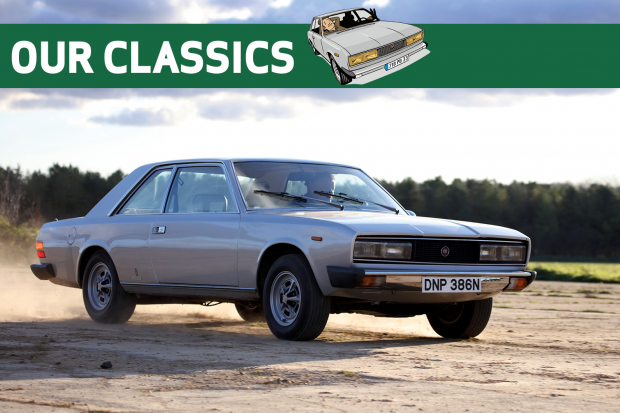
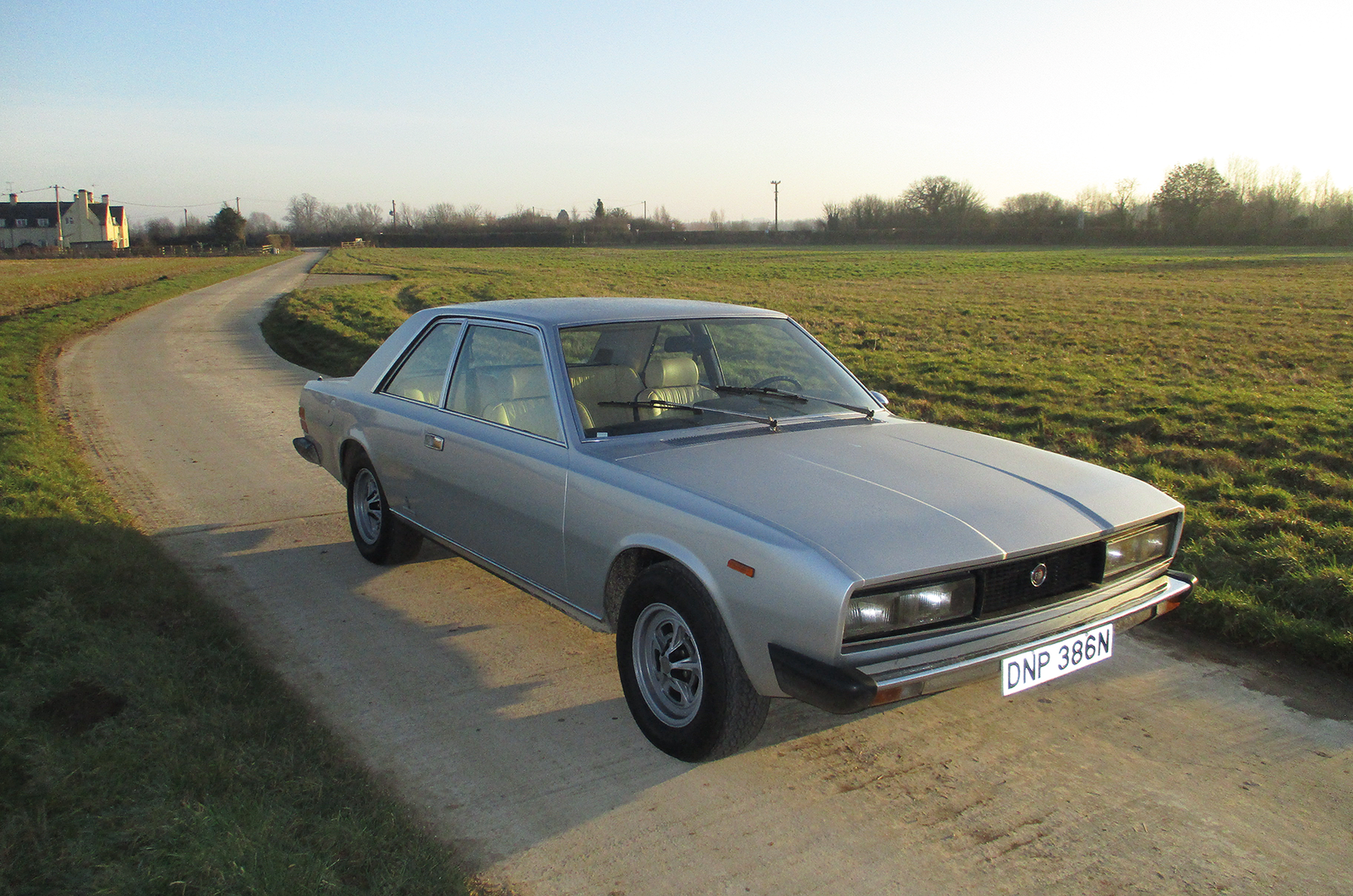

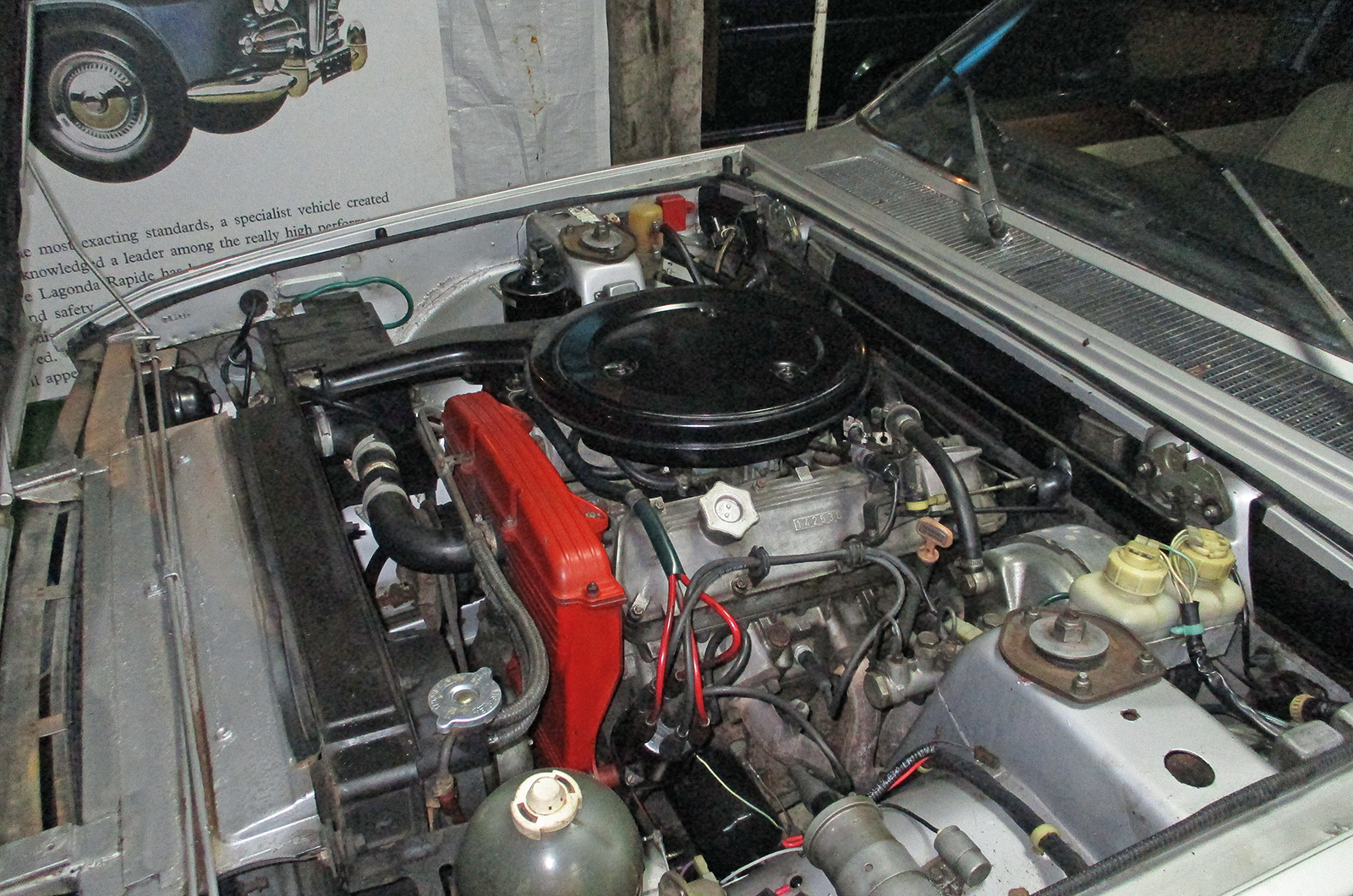
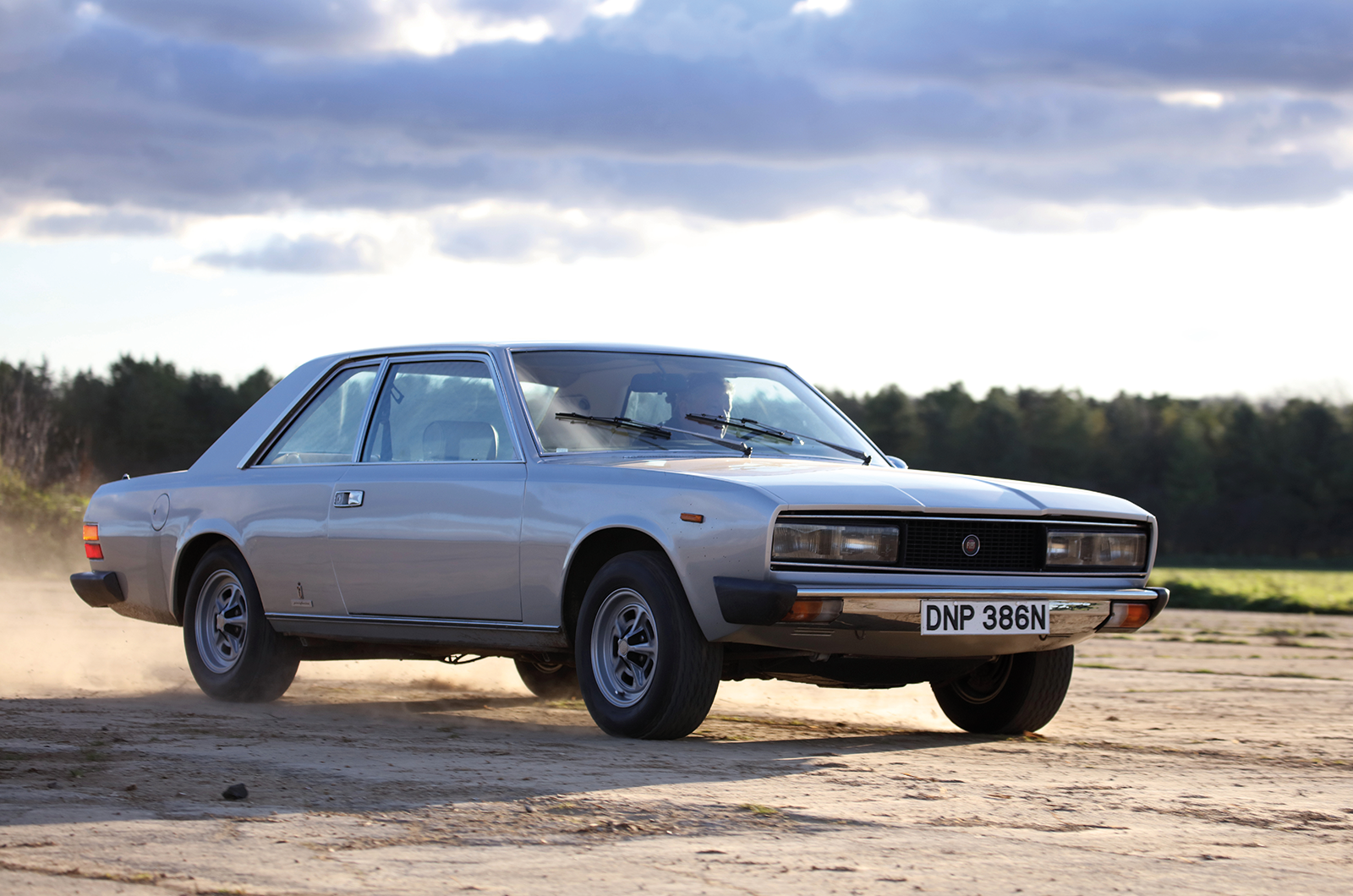
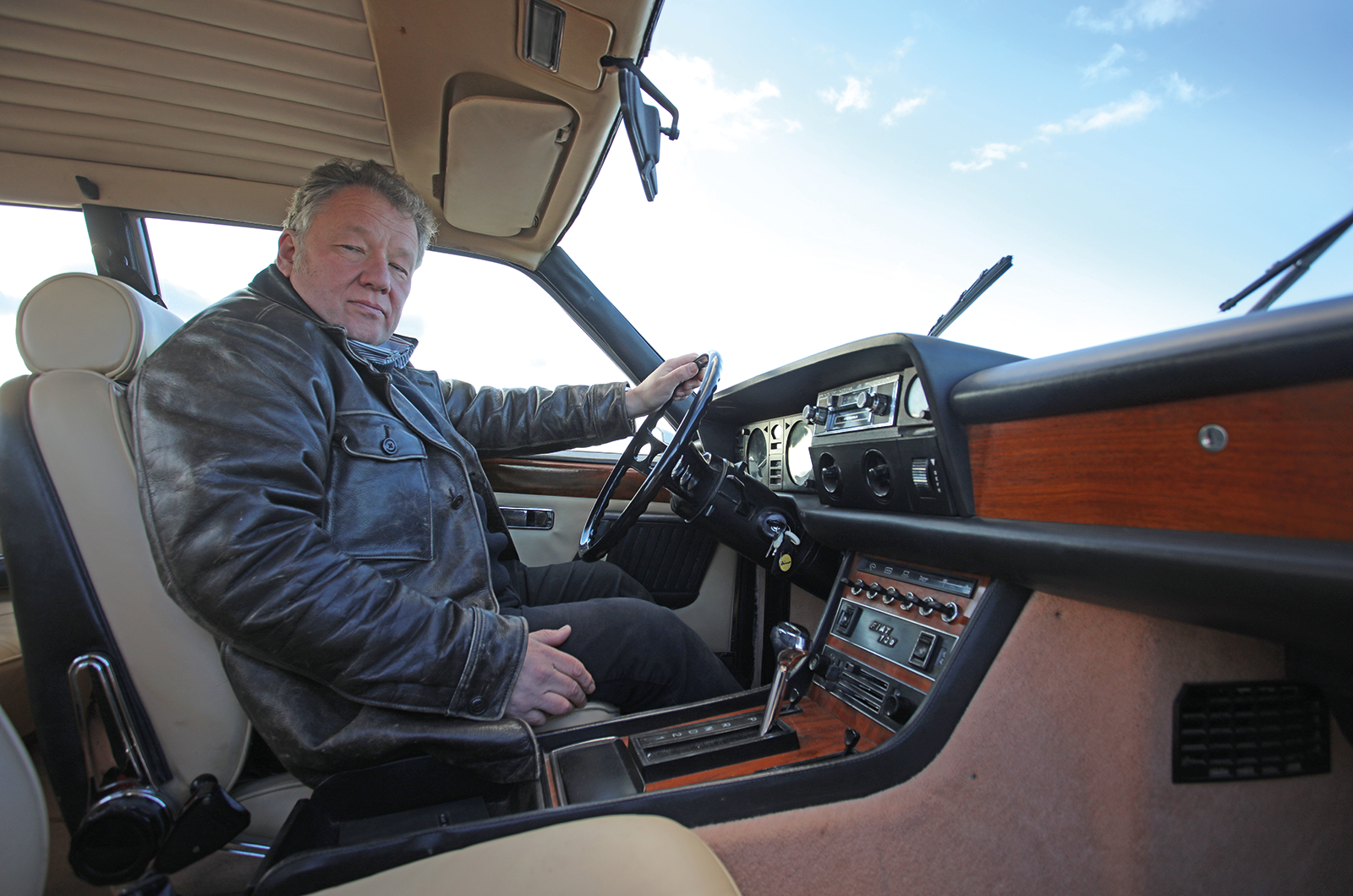
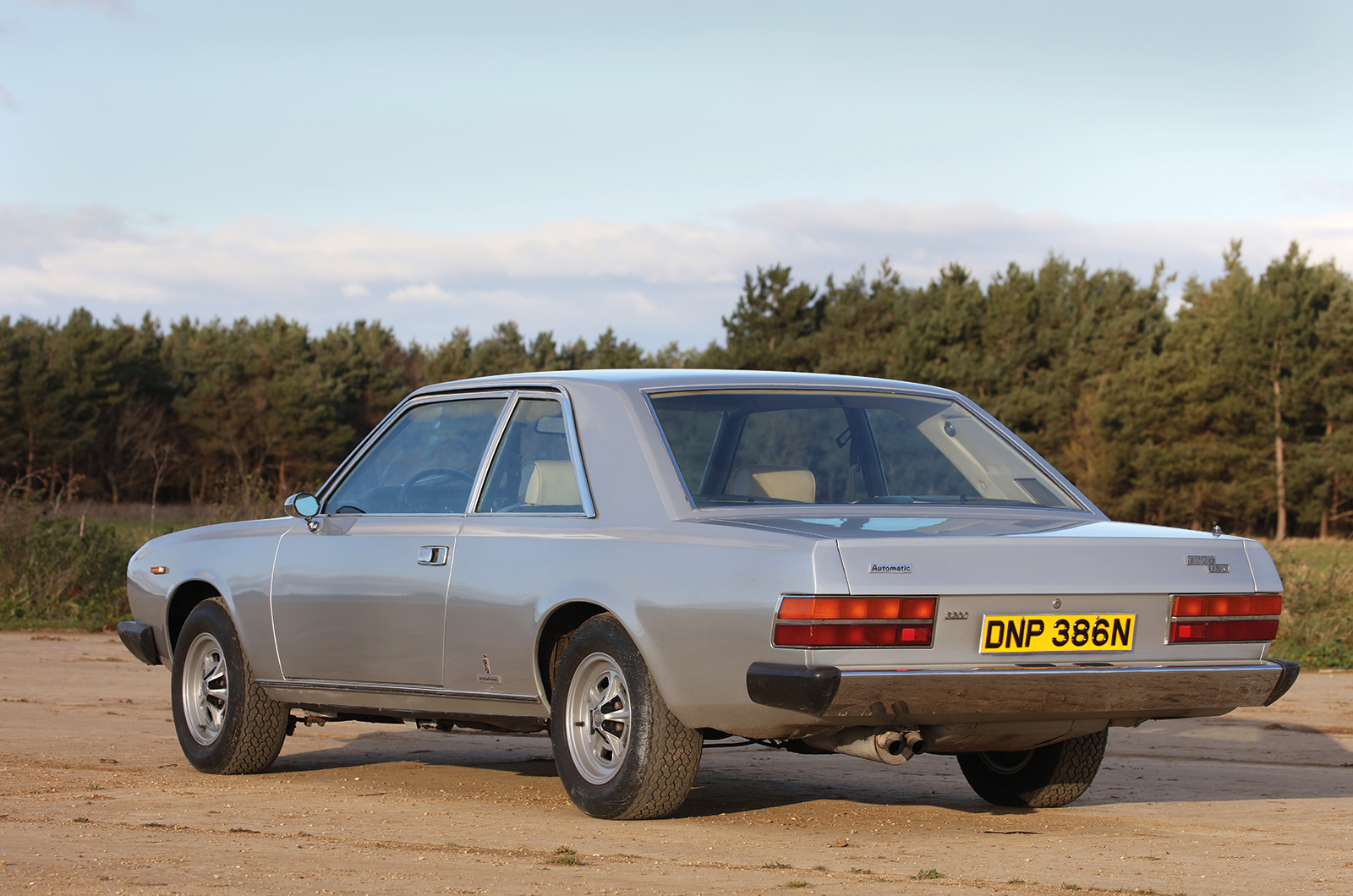
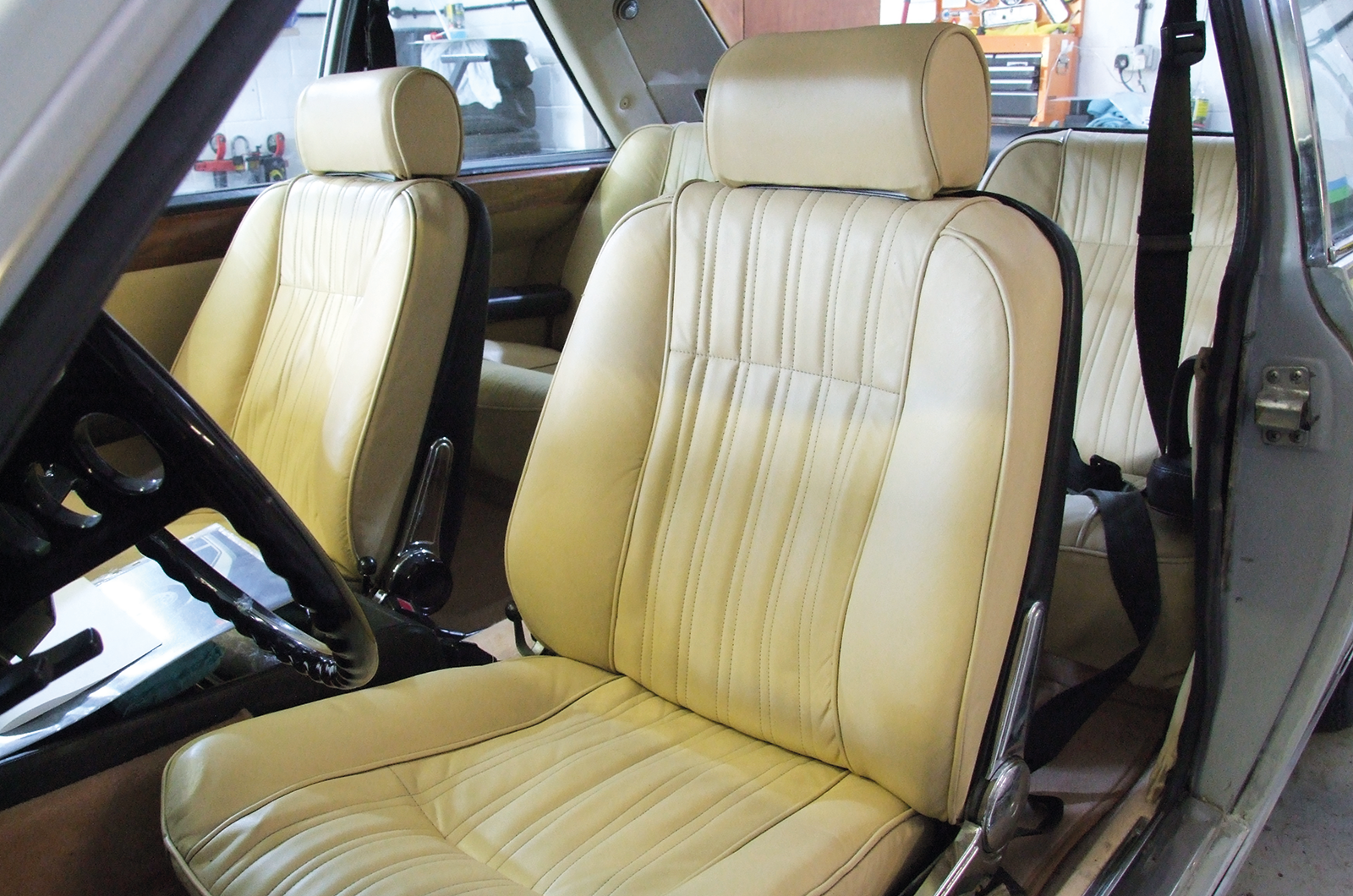
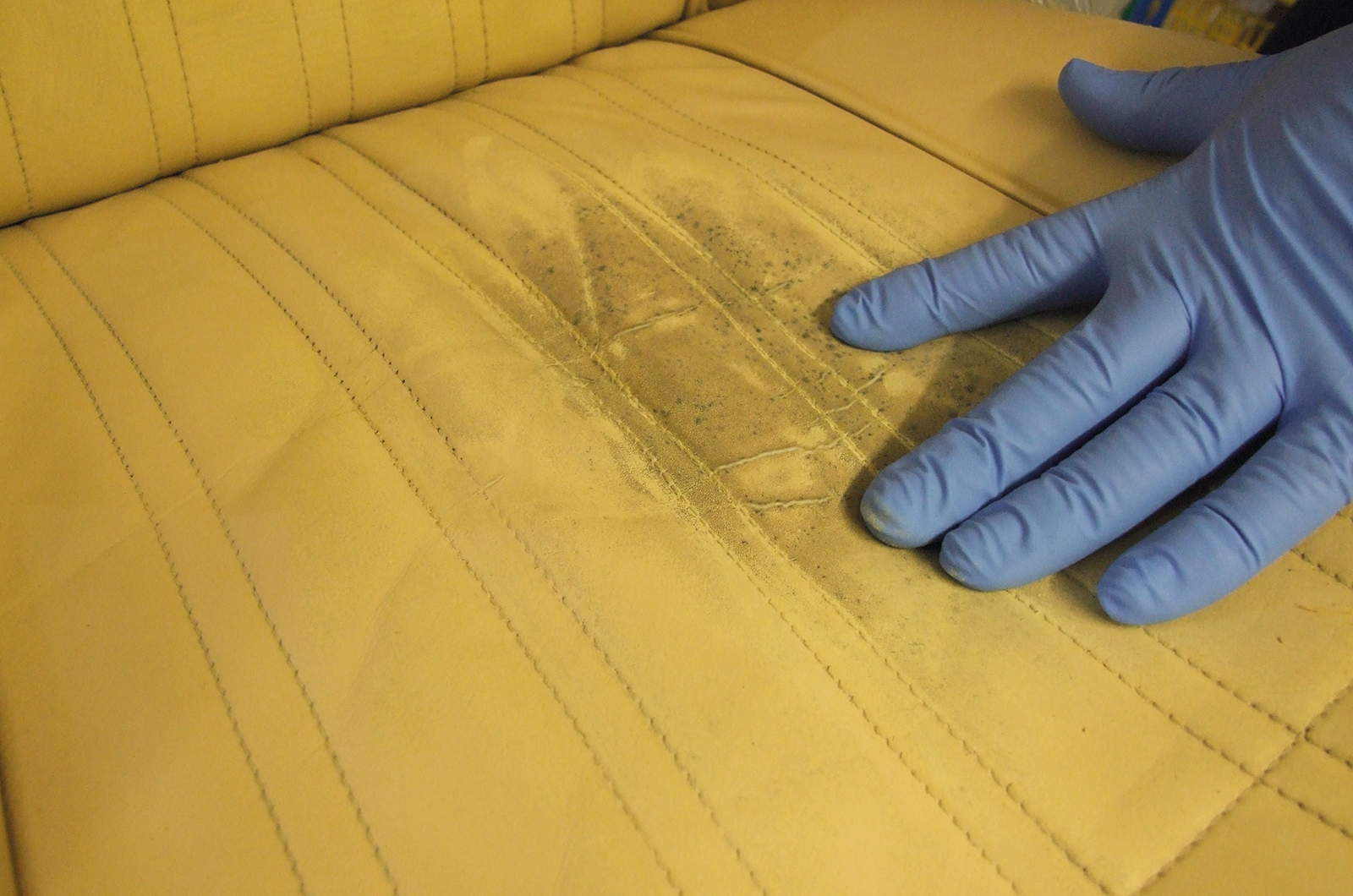
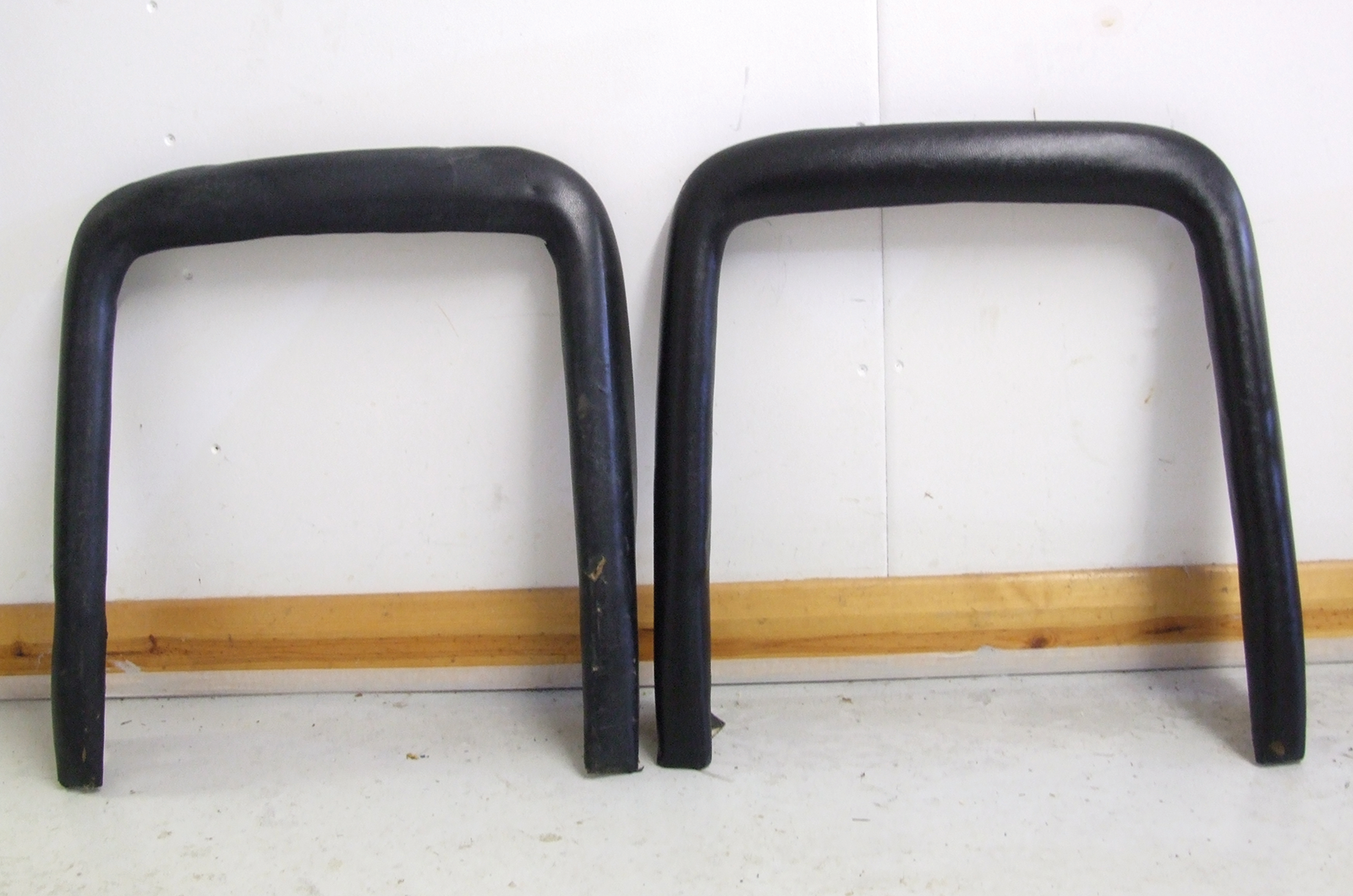
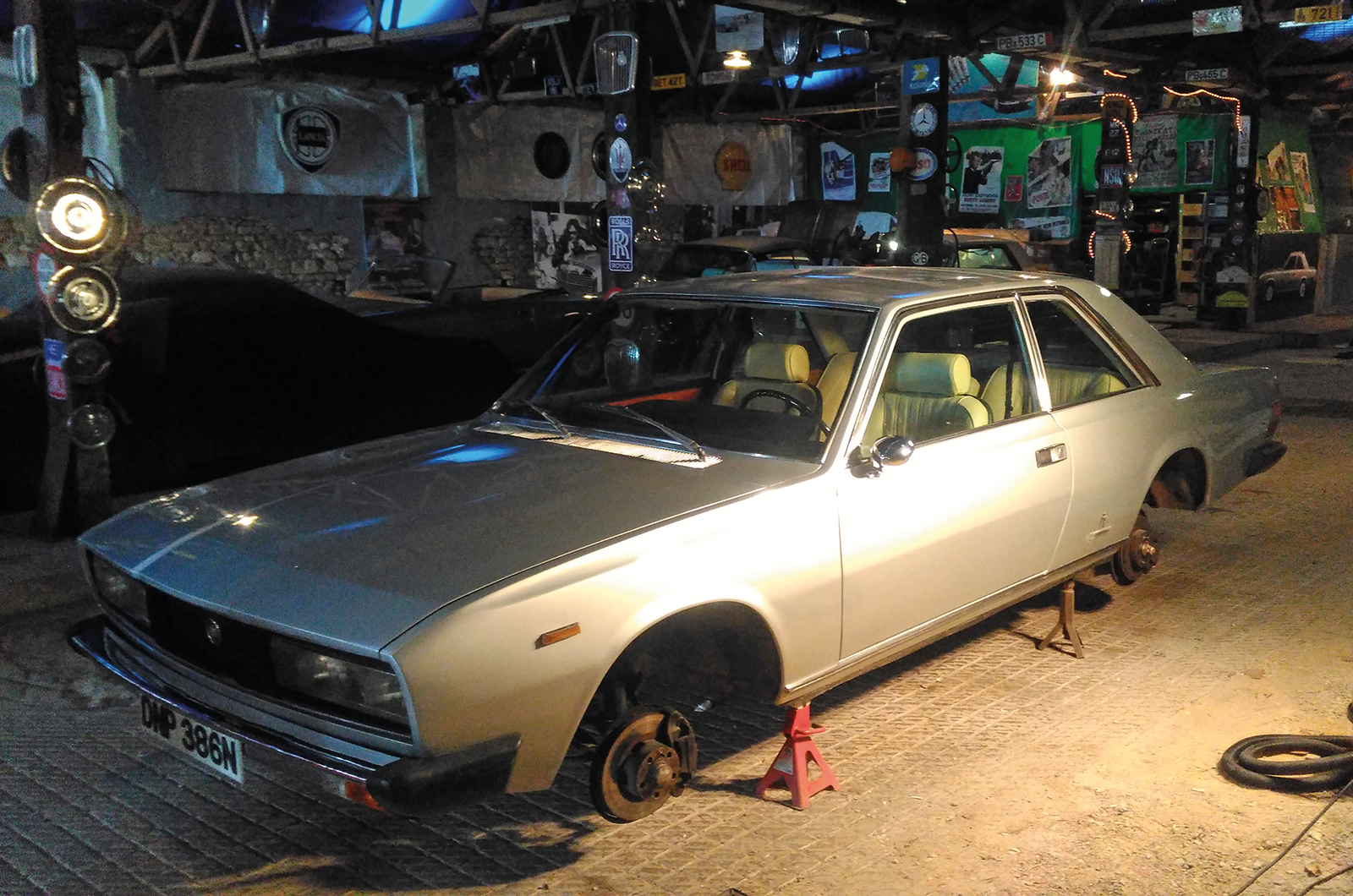
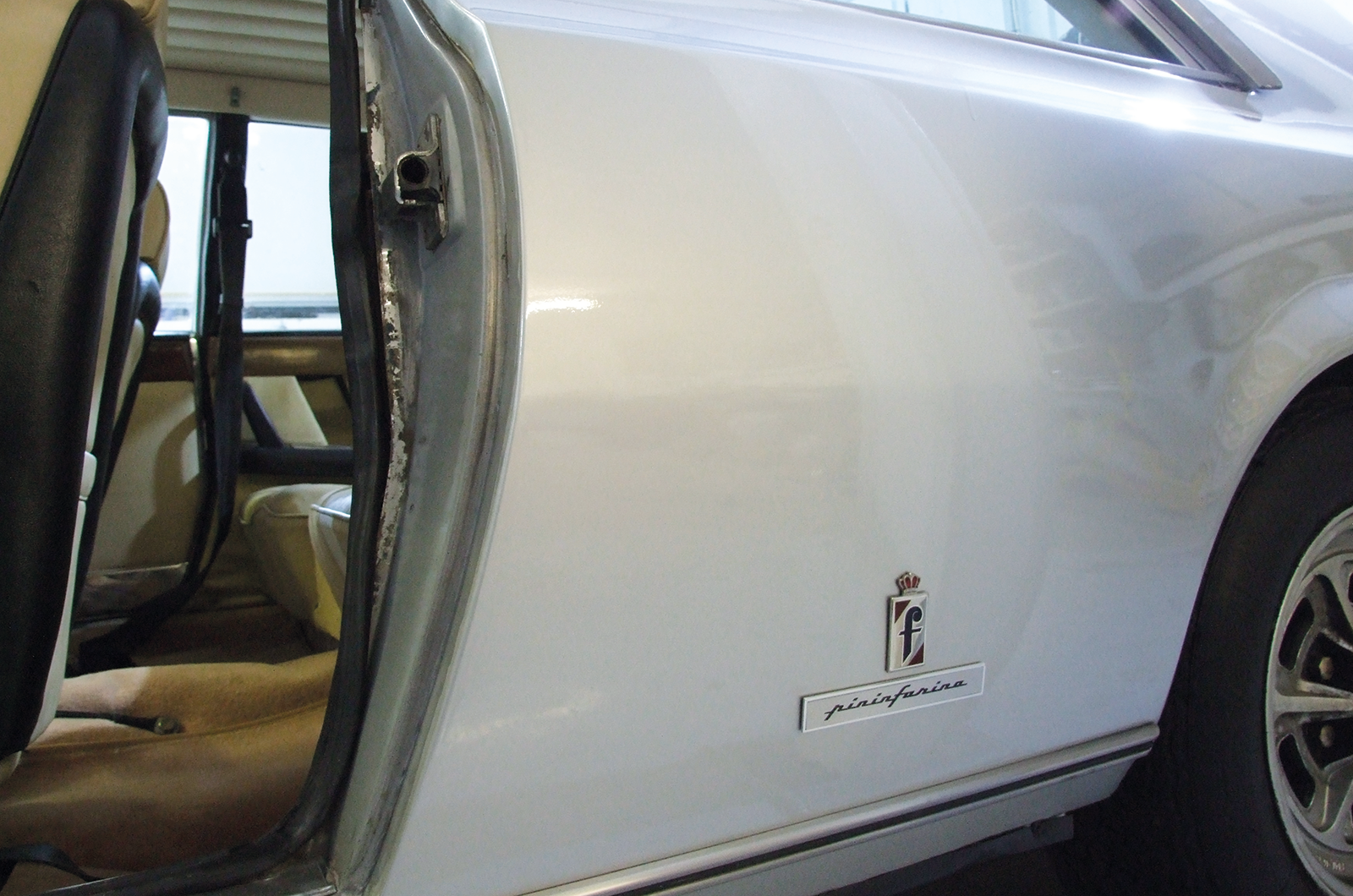
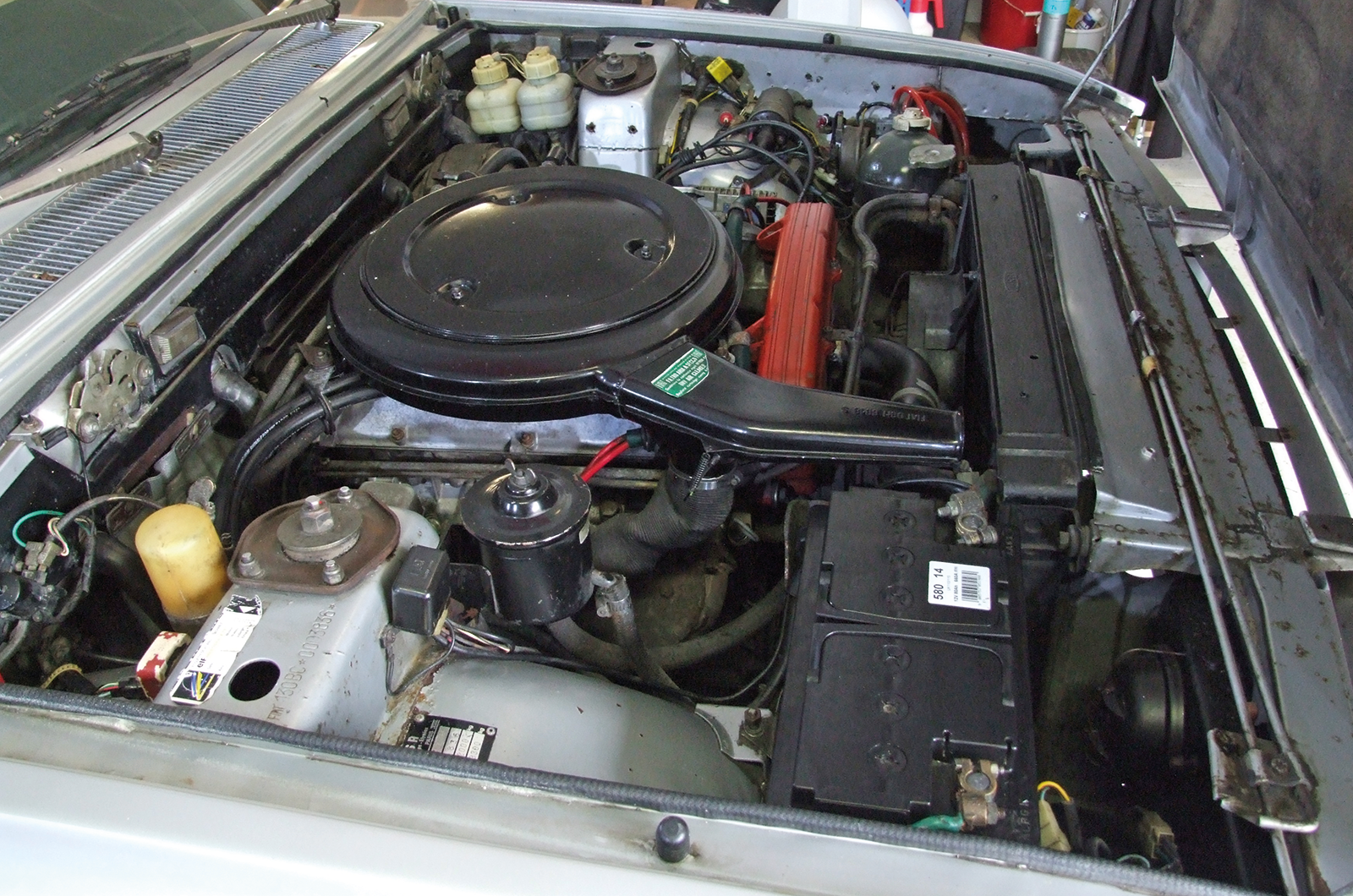


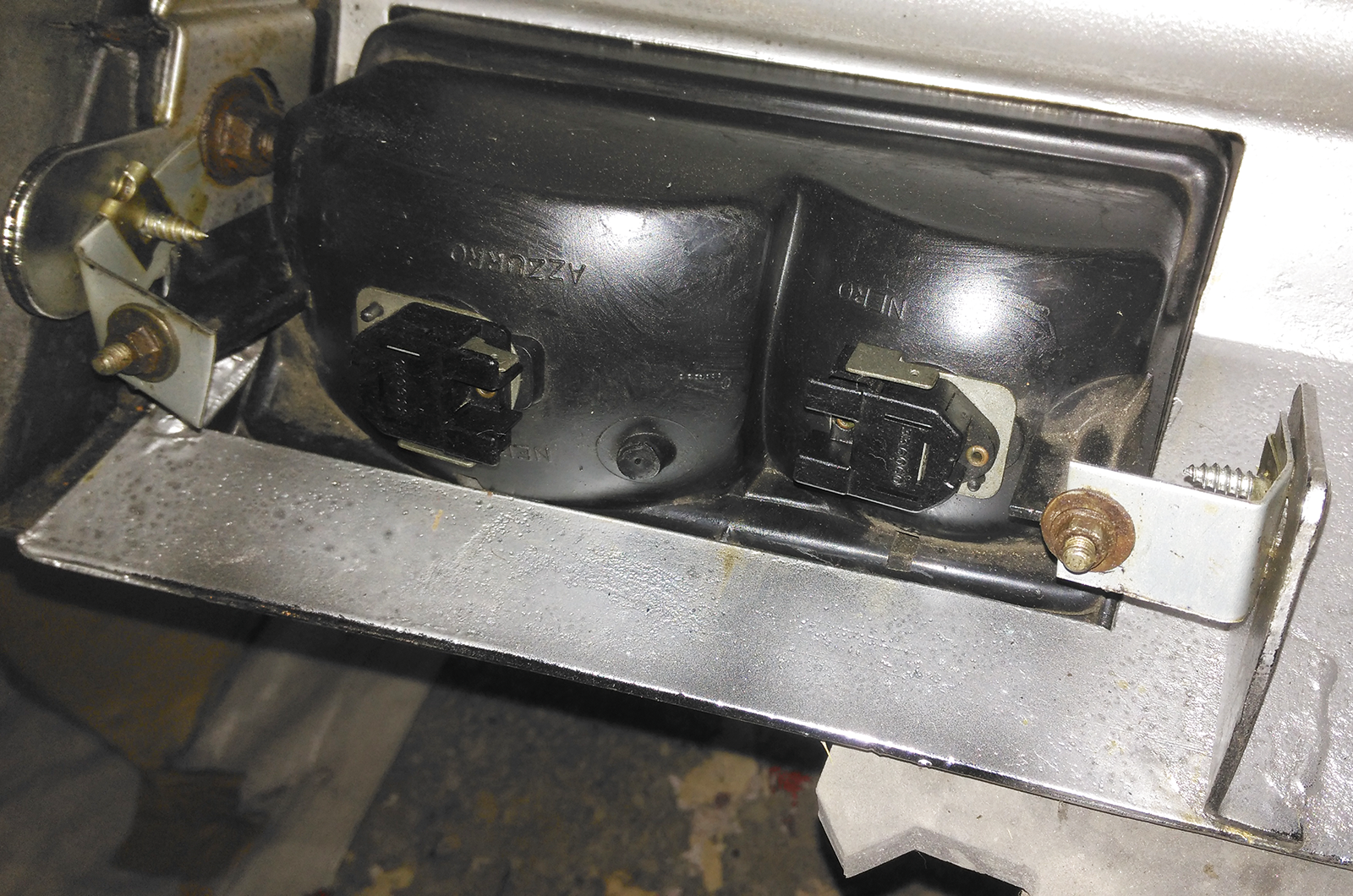
 The 130 Coupé has made its way to Cotswold Classic Car Restorations’ bodyshop, and any day now will have a new topcoat on it – I’m just awaiting the colour code from Italy.
The 130 Coupé has made its way to Cotswold Classic Car Restorations’ bodyshop, and any day now will have a new topcoat on it – I’m just awaiting the colour code from Italy.
 Jonathan sat me down and gave me a little talk about spraying cars. “The original paint on your Fiat is bleached/oxidised so we will have to go back to bright metal,” he said. “The trouble is, it is now unstable so you don’t want to be covering that surface with modern solvents and thinners because it reactivates the original coating. Modern car paint is better: it uses a system whereby two chemicals react with each other and set them off hard rather than relying on the old in-air drying process so they are more durable and not as susceptible to acids in bird poo and so on.
Jonathan sat me down and gave me a little talk about spraying cars. “The original paint on your Fiat is bleached/oxidised so we will have to go back to bright metal,” he said. “The trouble is, it is now unstable so you don’t want to be covering that surface with modern solvents and thinners because it reactivates the original coating. Modern car paint is better: it uses a system whereby two chemicals react with each other and set them off hard rather than relying on the old in-air drying process so they are more durable and not as susceptible to acids in bird poo and so on.
 The biggest question was what to do with the faded and scruffy blue velour/velvet interior. In many ways this has always been a big part of the model’s appeal, both when it was new and now. The problem is that the stuff doesn’t last and no trimmer will accept the challenge of letting good pieces of spare velvet into what is already in the car. The stuff is just too fragile, particularly when the sun has got to it and left it brittle and prone to splitting. From what I can gather, everybody is having this problem with Fiat 130 Coupés that have had any kind of serious use.
The biggest question was what to do with the faded and scruffy blue velour/velvet interior. In many ways this has always been a big part of the model’s appeal, both when it was new and now. The problem is that the stuff doesn’t last and no trimmer will accept the challenge of letting good pieces of spare velvet into what is already in the car. The stuff is just too fragile, particularly when the sun has got to it and left it brittle and prone to splitting. From what I can gather, everybody is having this problem with Fiat 130 Coupés that have had any kind of serious use.
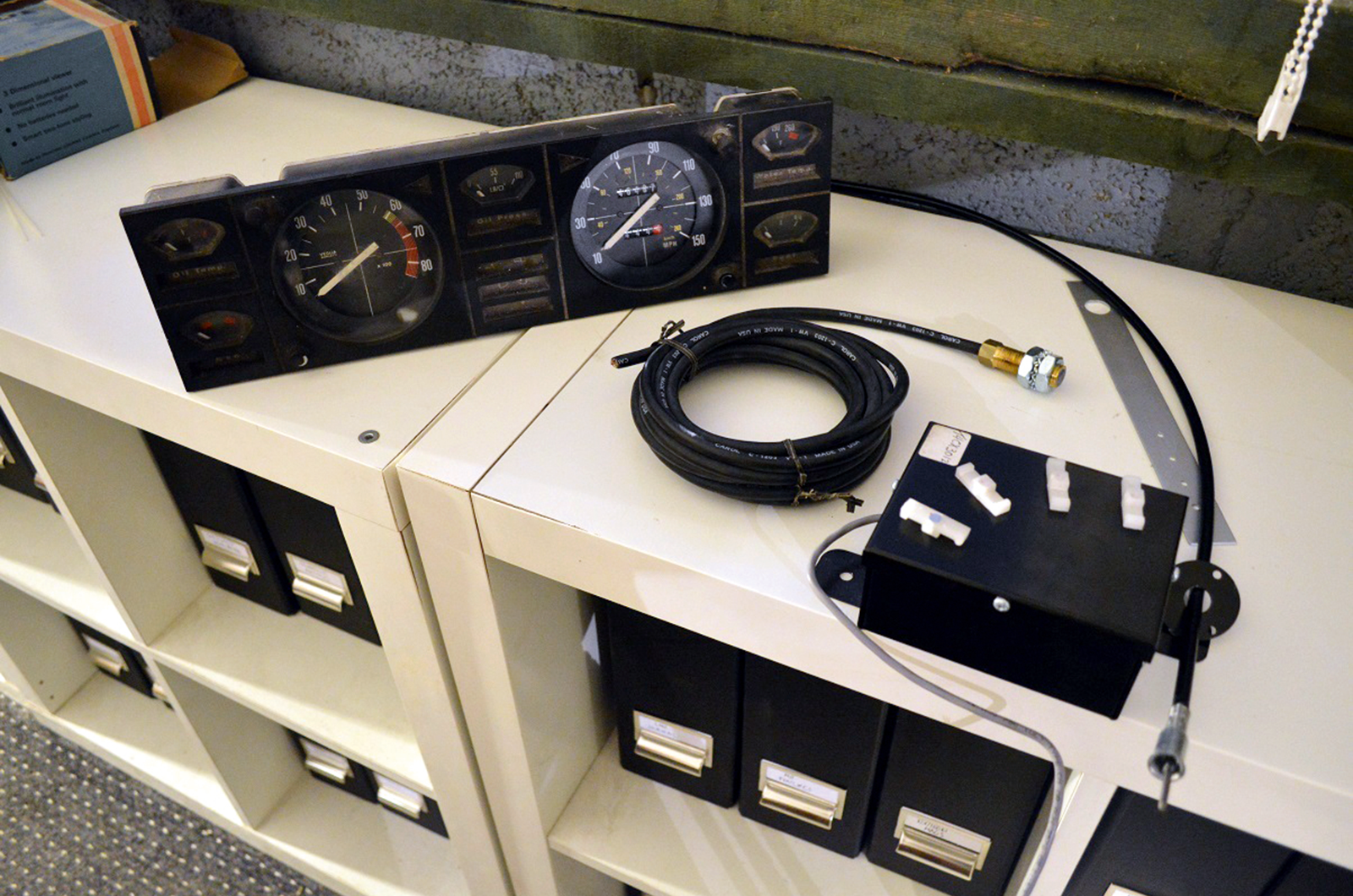
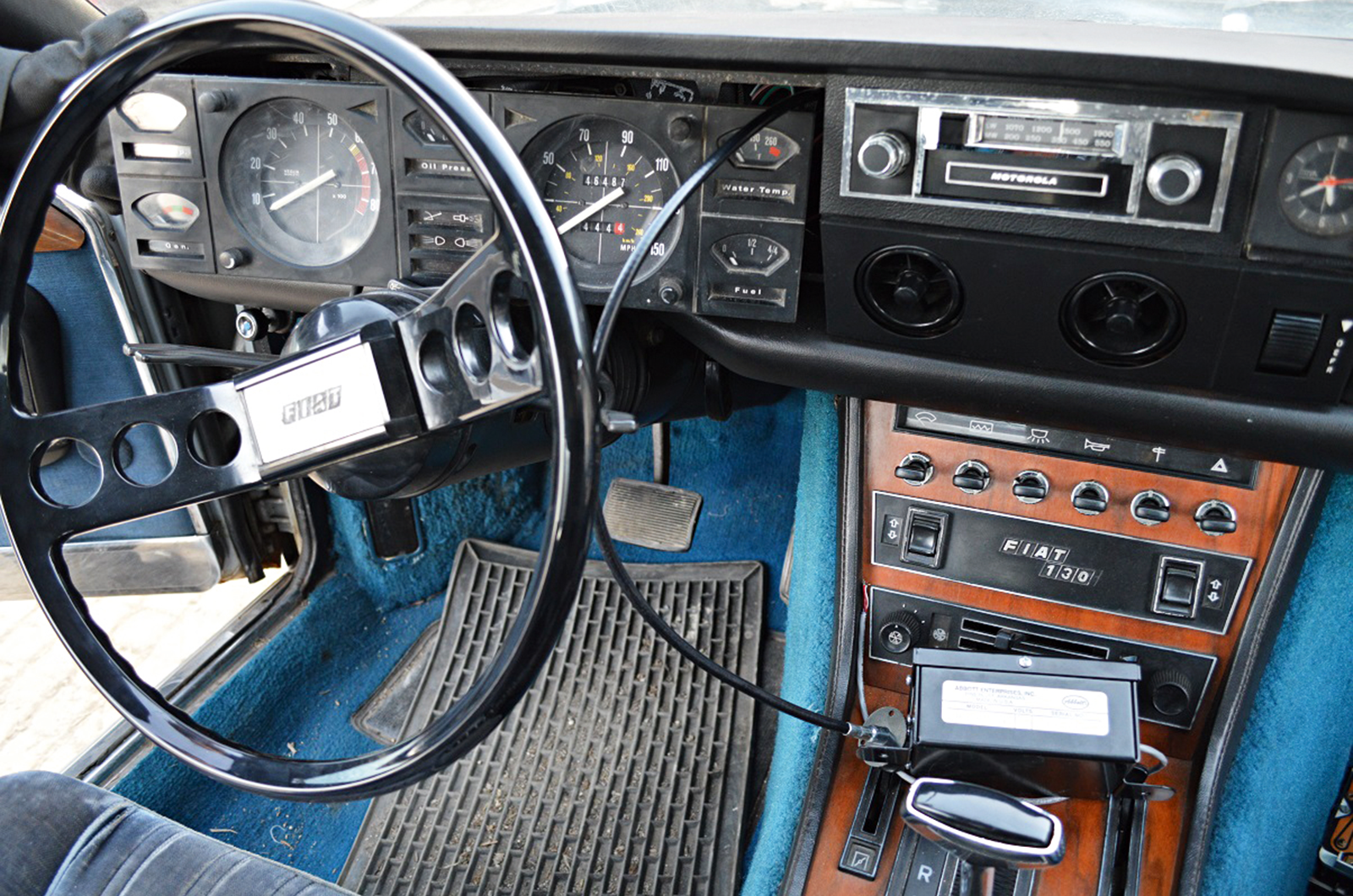

 The interior doorhandles are notoriously fragile on 130 Coupés, so I found enough remnants of part-dismantled items for Brian
The interior doorhandles are notoriously fragile on 130 Coupés, so I found enough remnants of part-dismantled items for Brian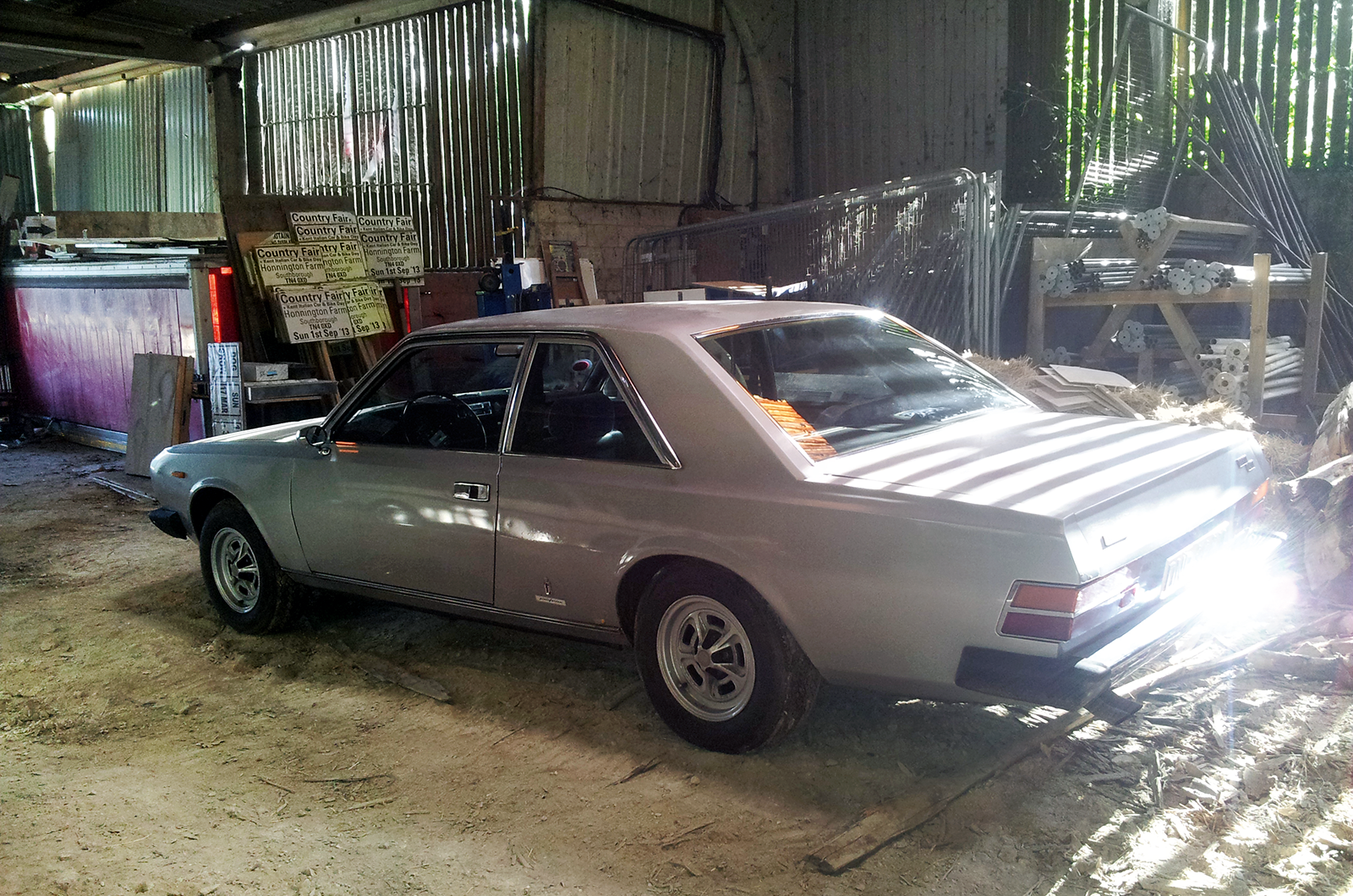

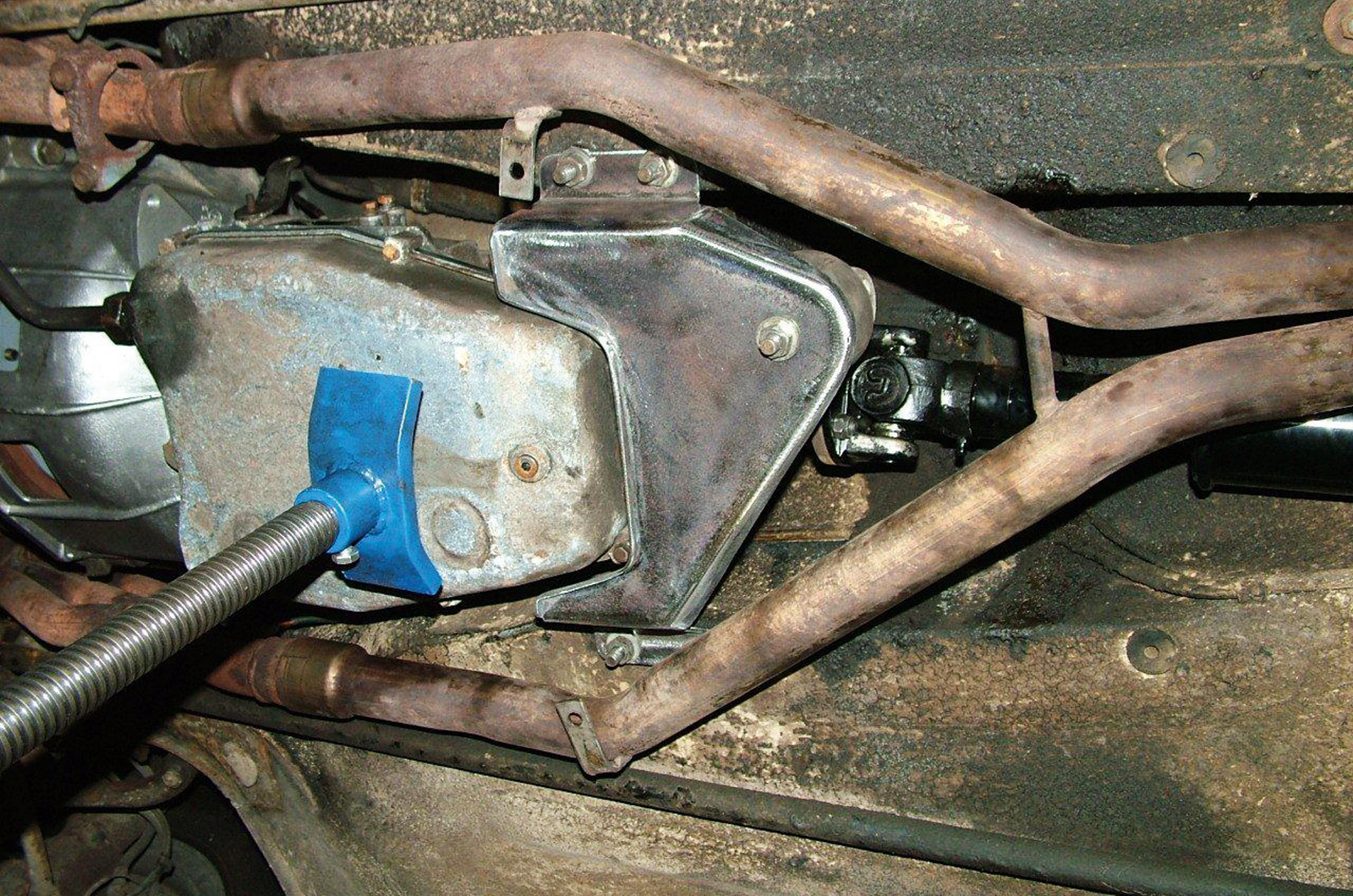
 I sort of knew there was a reason why most of these cars came as automatics and Richard’s car confirmed it; something about the 130 seems out of kilter with the idea of a manual ’box, which feels ever so slightly agricultural in this suave environment. Thus, I was determined to get the four-speed ZF conversion under way, hence the delivery of my silver Coupé to Mark Devaney.
I sort of knew there was a reason why most of these cars came as automatics and Richard’s car confirmed it; something about the 130 seems out of kilter with the idea of a manual ’box, which feels ever so slightly agricultural in this suave environment. Thus, I was determined to get the four-speed ZF conversion under way, hence the delivery of my silver Coupé to Mark Devaney.
